#hg dictionary
Explore tagged Tumblr posts
Text
High Gavellian Dictionary #17
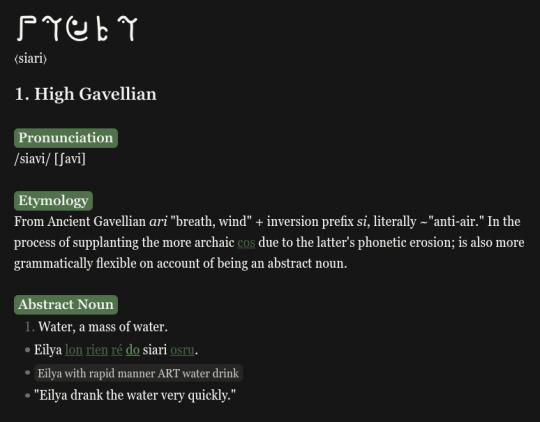
4 notes
·
View notes
Text
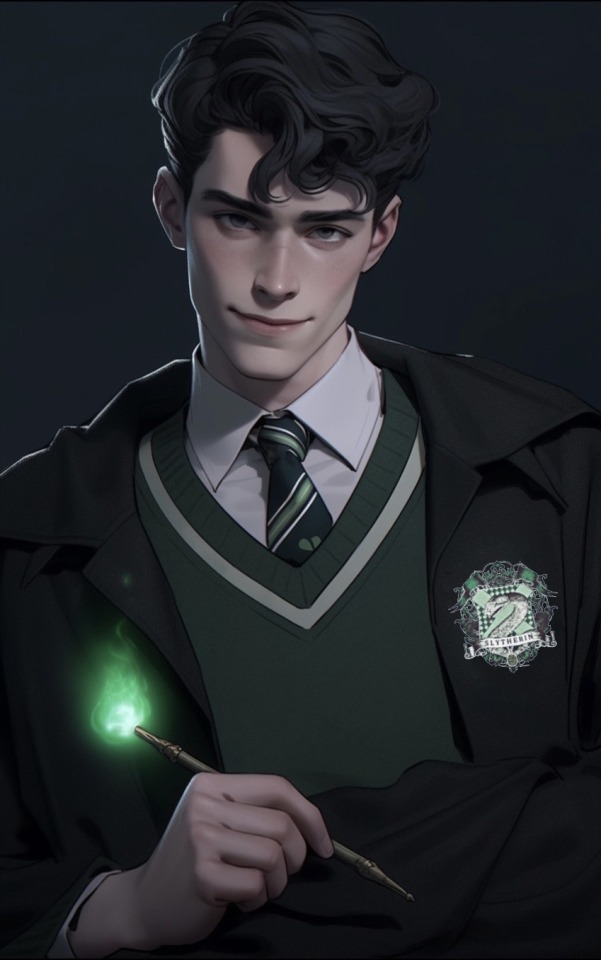
Purest Puzzle,
Don’t address me as Hermione, or must I actually curse you for my intentions to be clear?
Did you know that Tom means ‘innocence,’ or ‘purity�� in Hebrew? I find that delightfully ironic.
You seem keen on gaslighting me into thinking that you weren’t, in fact, hiding behind a bookshelf whilst staring at me. Perhaps you should grab a dictionary on your next impromptu trip to the library. On second thought, to save you the effort…and the next victim, “to pursue or approach stealthily,” is the definition you’re looking for.
It’s alright, I won’t tell anyone that you like stalking girls. You don’t have to talk your way out of it, but would it really hurt to put a bit of effort into the things you do?
Regarding the sweet offer from your letter, I wouldn’t dare lean on you, Head Boy, because you’ve got so much product in your hair that I’d probably slide right off.
You say I’m brash and yet you’ve already called me an abomination! I didn’t know strawberries were so aversive to you. I’ll have a chat with the house-elves and ask if they wouldn’t mind mixing tiny bits of fruit into your every meal.
Also, waffles distribute the syrup better. Pancakes are glorified sponges.
If you were my ‘cup of tea,’ I would be dead from poison intake. You are diplomatic in the way of a politician, I suppose. Clever, however? Still debating. Then again, you never claimed that you were those things, only that you preferred them in your company.
I’m thrilled to meet these impressive friends of yours after the holiday. Fingers crossed they’re the ones who might find my nature charming.
Don’t worry about speaking with Dippet regarding my OWLs, I wouldn’t want to take time out of your busy schedule of skulking about the castle. What were your exam scores? Whatever they were, I’m planning to surpass them. When we take the NEWTs, perhaps we can have a proper rivalry. A very distant, very unacquainted, lonesome rivalry, of course.
I asked you to leave me be, and yet I’m writing you another letter. I’m afraid that my pride won’t allow you to remain unchecked. As you said yourself, don’t write such a terrible letter to which I have no choice but to respond.
Happy Christmas Eve Eve! In two days, you can put the coal in your stocking to good use, rather than casting all those incessant warming charms on yourself.
With indifference,
HG
FF: “This is how you lose the time war” by @fleabagshair
AI-art by Your Journey , commissioned by me
248 notes
·
View notes
Note
Oh I have a few more questions about Corey if you don't mind!
What are their relationship like with each of the rangers + Mortum + HG?
How did they react to Chen's revelation that he was suspicious about his death after HB and choose to not investigate it further? I know for my step it was very traumatic.
Been sitting on this one for a bit trying to think up good responses. Replayed it a couple times trying to narrow things down too lol
I'd love to share more about Corey!
Under a cut for length
Relationship between Corey and the Rangers/Mortum/HG:
Ortega
Corey and Ortega were as together as sidestep was willing to get pre heartbreak incident, which was complicated. Ortega never pushed for more out of respect for their boundaries and worry about scaring them away (they were head over heels in love with each other. But sure, best friends that kiss it is). When they reunite, Corey is initially hesitant to open up out of concern their old feelings will come back and they wont be able to focus on their goal as heartbreak (correct). The romantic tension comes back with a vengeance, and Corey and Ortega get together again. If you look up "ride or die" in the dictionary, there's a photo of these two. A relationship they both agree is worth sacrificing their morals for. EXTREMELY codependent. Corey very quickly loses steam on their turn-villain-get-angry plans once they reconnect with Ortega. Now they really just want to be Sidestep again. They feel very vindicated that Ortega cares about them/ believes in their cause enough to be willing to "switch sides" and break them out post crash.
Chen
Corey has always been anxious around Chen bc of how obvious his suspicion was. Historically very very worried about being found out due to Chen digging for information (still not convinced that isn't how the special directive found Sidestep in the first place). Realizes during retribution that he was only trying to protect Ortega and is starting to warm up to him/be friendly (which Chen ruins very quickly by admitting that he knew the whole time and did nothing). Lot's of camaraderie around the shared experience of soldier/people shaped weapon with chronic pain and trauma that loves dogs. They'd be best friends if they could stop antagonizing each other. Both at least acknowledge the potential friendship there, even if neither are willing or able to pursue it by the end of Retribution.
Argent
Corey really likes argent, but the feeling is NOT reciprocated. She thinks they're selfish and a coward. They piss her off in pretty much every interaction they have during Rebirth and Retribution. Once she finds out Corey is the one that possessed her, her irritation with them turns to hate. This relationship is probably not salvageable. (Romanced her once, had to change almost everything about Corey's personality and fighting style to get her to like them lol) Respects her even more after she scars their face post-reveal. Thinks she had every right to hurt them and admires the restraint it took to not blind them. Reminds Corey of themself.
Herald
Corey Does Not like Herald at first. Only when he reveals that he genuinely enjoys their company and isn't just being a Sidestep fanboy do they change their mind. Goes from being nice out of pity/guilt to actually caring about/ wanting to protect him over the course of their training sessions. Being around Herald's unrestrained positivity has an effect on Corey's mental state similar to how they feel around dogs. Mr sunshine is contagious. Corey's starting to realize that's a front and that they should keep an eye on him. They're worried about his mental health (immense guilt over being the reason he's hurt). Bursts into tears mid apology when Herald comes to confront guiltystep in the hospital. Reminds Corey of Anathema.
Mortum
Corey and Dr Mortum get on like a housefire. They briefly flirted as the puppet before things got serious with Ortega, then broke it off to just be friends (If I weren't such a sucker for the decade long slow burn friends to lovers, Mortum would beat Ortega for favorite romance). They have admitted to being a re-gene to Dr Mortum and desperately want to make the friendship work (that Mortum didn't immediately kill them or turn them in has Corey smitten. The bar is on the floor). Using mirror image puppet for Ortega romance purposes in canon route, but the coming out scene with Mortum and a questioning step happens regardless of the puppet gender in my head. Corey really needs to vent about their dysphoria to somebody. The amount of trust Corey needed to out themselves as a re-gene to a "well connected scientist" like Dr Mortum is crazy. Especially with how horrible their medical trauma/anxiety is. Hopefully Mortum knows how big of a deal that was and they can reunite soon.
Hollow Ground
Corey and HG have a very tense but amicable professional relationship. Undecided on the canon route here, but either 1. They saw and resisted HGs threads without getting caught, and intend to use that to manipulate HG in the long run. Or 2. They were their usual defiant little shit self and refused to shake hands, and know nothing about the threads. Trying to figure out the various ways to keep the subtle manipulation stat high enough to see the threads without losing other story moments I like for them. As much as Corey would like to stay detached and hate HG for how many people he's hurt, they secretly love Ortega's theory and hope that its true. They want a loving protective big brother so bad. Intends to hide the re-gene thing from him as long as possible to avoid losing the potential business (and sibling) relationship. Side note: Not my canon route, but I have played through with Hollow Ground as Corey's villain name bc I think it'd be hilarious. Naming yourself after the fake villain your ex is obsessed with only to find out they're real and also you're related is a beautiful comedy of errors waiting to happen.
Regarding Chen's suspicion:
Corey and Chen's relationship had improved dramatically over the course of Revelations, which made the fallout from this even worse. Corey was just starting to think of Chen as a friend rather than a reluctant acquaintance. When he tells them about the photos and that he chose not to investigate further despite knowing what had happened to them, it breaks their heart. Instead of reacting as they usually do (getting angry and lashing out the way Chen expects them to), they just start crying (trauma has NOT made them stronger, they cry a lot easier now and they hate it). Poor Chen was braced for an argument and thinks somehow getting screamed at would've hurt less than seeing them look this defeated. Corey feels betrayed and abandoned, and really wants to hate Chen for not coming to rescue them. After some time to think about it, they realize that also means that even though Chen KNEW they were a re-gene he decided to be friendly toward them anyway. Their friendship will take a long time to rebuild, but its not permanently gone.
7 notes
·
View notes
Text
Chinese listening experiment:
I have some thoughts on developing listening skills versus reading skills.
Summary: any abilities to extensively read and extensively listen, quickly come back if you do the activity again. The things you can extensively read and extensively listen to and understand, will reliably come back after breaks in study. (at least for me)
I learned reading skills first, basically doing what Heavenly Path's Comprehensive Reading Guide suggests: intensive reading where I'd look up hanzi in Readibu or Pleco, extensive reading every so often too (in order to build up reading stamina and ability to read without being able to look words up), from Graded Readers to Children's stories to Webnovels as I gradually increased the reading level. (I really recommend that guide as I learned to read that way, and many other people who've mentioned learning to read Chinese also utilized some of the suggestions in that guide).
My reading skills in Chinese basically developed just like my reading skills in French did except with less cognates from English to rely on lol.
All reading skills developed similarly to how my reading skills in my native language English developed. When I was little, around 5-7, I had a toy where you put a book made for the toy into it and could 'tap the words' with the toy's pen, and the word would be read aloud to me. Which nowadays, you can do on cell phones with TTS, and I used TTS to listen to French and Chinese pronunciations of new words as I read. But back when I was 5, this toy was how I listened to words I read, if I didn't know their pronunciation, and how I heard them out loud to recognize if I knew them. I also learned words in school, from dictionary definitions, as many children do. With word lists, with textbooks and their word definitions we'd have to study, with reading assignments where the teacher told us to find X words we didn't know and write the definition. That was similar to reading French and Chinese later, and looking up the translation/definitions as I read. I got older around 8-10 and I read any books I could pick up at home, or when we'd go to the library, and I started guessing a lot of unknown words from context instead of bothering to look up the meaning in a dictionary. Catwings, Bunnicula, then HP and books assigned in my classes like Holes. Then random books I'd pick up at my house like Michener novels and other dense books for adults I could barely understand, but I sure was getting the 'gist' of the main idea. By 11 I could read fanfiction, and since it was on the computer, I could switch between guessing some words from context and looking some words up by definition online.
I could read Twilight and understand everything except a few words I know I guessed, and I could read books for adults like Dracula, Prince and the Pauper, HG Wells novels, and definitely understood the main idea and most details - though some of the literary analysis elements like themes and symbols escaped me until age 15-16. So by 9-10 I remember being able to read mostly whatever I wanted for the rough main idea, and depending on what the material was it would be frustrating to read more of (like Michener novels or Shakespeare). By age 11-12 I could read pretty much anything I wanted and at least get the main idea and some details, even if I picked up a college textbook or a dense novel for adults or an old novel. By 16+ I could read anything I wanted for the main idea, most or all details, and literary meanings.
Well reading in French followed a similar pattern, except I stopped working intentionally on reading skills once I reached the 'read whatever I wanted for the rough main idea' point. And just over the years as I kept reading, it got to 'read whatever I wanted for main idea and some details' though I'm not confident I could do a literary analysis of the things I read in French. Reading in Chinese followed a similar pattern, which I am still intentionally working on developing my reading skills more, as I would like to grasp the nuance of themes and symbols and imagery and metaphors in the Chinese novels I read. I read French nonfiction mostly and the depth of analysis I want to do is generally only as deep as "what is this historian's opinion of X event, what are they trying to convince me" or "what is this news article writer's opinion of the event." Which is a level of analysis I can do for French nonfiction, so I can do what I want. In Chinese I read a lot more fiction, and I do already notice things like writing style (to a degree), imagery (to a degree), and themes (to a degree), but things like 'references to other works' I will definitely need to learn a lot more to pick up on.
My point is that learning to read pretty much followed the same pattern in all languages. And like with English, the skill of being able to read never really 'is lost.' I have gone 2 years without reading a French book, then pick up a French book and within a few hours the ability to understand all the words I could understand LAST time I was reading comes back. I have gone 6 months without reading a Chinese book, and as long as I pick up something I've read before, the ability to read the words (remember the words and hanzi and grammar) comes back within a few hours of reading.
*I never have any time periods where I totally avoid French or Chinese text - my Google account is in French so I see a little bit of french text every time I check my email, and I watch a LOT of cdramas so any time I see chinese hard subs I see some chinese text. I'm just saying I can avoid reading long form French or Chinese for months, or reading any significant amount of time per day, and within a few hours of trying to read again the reading level skills I had the last time I'd read a lot come back.
Not every word comes back - if I was in the middle of intensively reading a lot, and had looked up 500 words that week when reading a novel, 500 words I did not know well yet, then when I take a break and come back those 500 words will be unknown again. But my extensive reading ability is solid, and stays the same or improves, and I can rely on it. I can rely on being able to read and understand anything in the future, that I can extensively read now. Extensive Reading skills are solid reading skills that like drawing skills, come back even if you take a break.
Now, listening skills. What I am noticing from doing a lot of comprehensible input listening practice is this: extensive listening skills are the same. Extensive Listening Skills, the ability to understand words when listening, comes back within a few hours even if you take a long break from listening.
The words I look up in listening, those are the words I don't know well yet, and I do forget them if I take a break. But the words I have learned to understand easily when extensively listening, I can be fairly sure I will understand again the next time I extensively listen. Even if I take long breaks from listening.
So based on those things, I'd say Comprehensible Input Lessons 'stick' in your memory and the progress isn't 'lost' if you take breaks because... extensive listening skills aren't lost once they're developed. They can get rusty and require a few hours to practice and re-activate what you knew, but the ability to extensively listen isn't lost. However: if someone is using Comprehensible Input Lessons, each lesson obviously is introducing brand new words with new images/gestures/context, and those brand new words if you take a long break probably will be 'lost' and need to be 'relearned.' Just like if you were intensively reading and looked up brand new words, then took a long break from reading. The brand new words in Comprehensible Input lessons need to be repeated to you long enough for them to be 'well understood' and to become words you can recognize in extensive listening to say a podcast with no visuals, in order to be retained. Which is obvious... of course only words you can recognize with no visual aid (comprehensible input lessons or classroom lessons or a tutor), or no word lookups (if intensively studying), are the words you'll retain in long term extensive reading and listening skills.
You'll still HAVE those 'newly learned' words in your memory, since you were exposed to them at least once. And repeated exposure will continue to teach you those words when you come back to listening and reading. It's just they were the words you knew the least when you took the break, so they'll be the hardest to recall/remember and may need some more exposure before you do remember and understand them.
0 notes
Text
Star Trek, to me, is another good example of that kind of definitional fuzziness, because Star Trek is a science fiction series. Like, I don't think most people would dispute that. Star Trek is so foundational to what we think of with regards to sci-fi that you could put in a pretty solid argument that it's the modern sci-fi story. You could put a screenshot from Star Trek into the dictionary next to "science fiction" and a lot of people would nod their heads at that.
And Star Trek is absolute garbage at science. Always has been. (At least, with regards to the shows I watched and that people hold up as "classic Trek"; I dunno if any of the new ones are better about it but I haven't heard great things.) Star Trek gets scientific terms wrong on a regular basis, introduces concepts that range from scientifically implausible to flat-out impossible, and misuses a lot of the science it does use. Shows from TNG onward had "technical advisors", but their job wasn't to come up with the episodes or veto them for implausibility; their job was to come up with terminology that sounded about right, which would be termed "technobabble" exactly because most of it was completely meaningless once you tried parsing it.
And the thing is, none of that stops Star Trek from being science fiction: because while Star Trek has always skimped on the details, it's also classically preoccupied with the question of how science and scientific concepts change and affect human understanding, and how to deal with them.
Take the episode Relics, for instance: the plot of that episode deals with a Dyson sphere. And the thing about the Dyson sphere is, it's total malarkey. Freeman Dyson's concept (which even he considered more than a bit out-there) was a bunch of large structures surrounding a star (he considered "Dyson swarm" more accurate), not a single huge, rigid shell that fully engulfs it out to Earth's orbit. Such a structure would require a material stronger than anything we've ever conceived of to not rip itself apart, and enough of that material to outmass most stars to be as big as it is--in short, it's impossible.
But the important part to the creators was what the Dyson sphere concept represents: a Dyson sphere is a structure created by a culture that has mastered science to the point that it has caged a star and used it for power generation. That is why Dyson came up with the concept; the shadows of those huge structures passing over a star in a telescope lens would be an unmistakable sign of beings so far above us as to practically be gods. And that's exactly what the plot of the episode is about: pondering just who the hell could have built this thing, and what happened to them (and also Scotty being back).
And going back further, you have stories like the works of Jules Verne and HG Wells, or CS Lewis's Space Trilogy, or Fritz Lang's Metropolis, or going further back, Mary Shelley's Frankenstein. In all of those cases, though the science on display ranged from "reasonable for the time" to "complete guff", they are now completely fantastical, if only because they came about at a time where science was much less advanced. The Nautilus's feats are still impossible with the most modern technology, complex life on Mars does not exist, and a pre-diploma chemistry student raising the dead was so out-there even then that Shelley didn't try to explain it beyond "probably electricity." But they're all still considered science fiction, because they all hit on the fears that science was presenting in that era.
Or, to put it another way, Braveheart is still a historical epic despite most of the events of the film ranging from stretched to imaginary, because what matters is that it presents itself as a depiction of a great moment in history. Gigli is undeniably a romance despite the lead romance being utterly unconvincing, because it's still about how two people grow to love each other. And a story doesn't stop being about science because the science in that story is ill-researched, loosely applied, or outdated. That's not how a genre works; a story doesn't stop being in that genre because the author made mistakes or fudged details. What matters is that the story is trying to think about the questions that science and scientific advancements make us ask, and presents itself as such.
My point about Star Wars as fantasy kept getting lost yesterday because I wasn't putting it plainly enough and I do think it's important.
I think of space opera as fantasy because it's not like WRITING sci fi, it's like writing a high fantasy setting like LOTR.
Speaking as someone who's written in all three genres. I think about space opera the way I think about high fantasy, when I'm thinking in depth about the worldbuilding at all (after all, one of my two major space operas is LOP, which I've said before runs on cartoon logic.)
People say they're not "smart enough" to write in sci fi and count space opera as if the Millennium Falcon weren't less grounded in reality than ents. Because yes, Treebeard is more realistic of a concept than the space jalopy the way Star Wars presents it.
When you're writing sci fi you're often trying to find a seed, at least, of some real world plausibility before you go rushing forward. Jurassic Park's exploration of cloning technology taken to a logical extreme, for example.
When you're writing a space opera like Star Wars the thing that usually matters is how YOU want it to work. Hyperspace is magic. The force is magic. Lightsabers.... Pretty much magic.
So when I'm talking about writing and I say that a space opera is fantasy I mean that you can just make the rules up yourself as you please.
And yes, as it's being pointed out to me by my housemate, you can HAVE a hard sci fi space opera, but honestly there's a reason it's rare.
I genuinely don't think anyone needs to be all that smart about science or math to write something approaching the harder sci fi end of the spectrum, but you don't need to know anything about science or math to write for Star Wars or anything like Star Wars.
Blasters and the Death Star don't care one bit about math, trust me.
35 notes
·
View notes
Text
battle royale marvel has won my heart
#there is? 1 person following me who cares#but br marvel? brought back my love for him#he just. he isnt competent bc hes not HG marvel who trained his whole life#hes modern marvel who owns 5 phones and lives on tiktok#who moves to japan and has Very Little capability to speak Japanese#and then a week later is thrown into this battle to the death w his new classmates#who dont know him and who he doesnt know and he barely knows the rules of the game#bc everyone talks so fast he cant keep up#and his weapon is a spear but his bag also had a japanese to english diary#bc they Knew the white boy would need it so before throwing it to him they slipped the diary in#dictionary* why did i write diary#im just too emo#i. ooc posts
1 note
·
View note
Text
A Dictionary of Alchemical Symbols
I was super flattered by all the positive comments and tags on my post about FMA:B’s alchemical symbolism. People seemed interested in learning more about alchemy, so I thought I’d post this here. This list is mostly paraphrased from A Dictionary of Alchemical Imagery by Lyndy Abraham, which is my main source. Brace yourselves, this will be long. (Disclaimer: The names and order of alchemical processes changes depending on the source. It’s a cyclical process, not a linear process. So I’m guessing at the order of the procedures.)
Abyss: Another name for Prima Materia, Chaos or the formless primordial matter from which the Stone is made.
Air: The androgynous, volatile, combined masculine and feminine principles. Its properties are hot and wet.
Alabaster: The White Stone, the material at the second stage of the work that can transmute metals into silver. It is purified and spiritual matter, body and soul (but not spirit yet).
Amber: Considered synonymous with gold, the product of the philosophical tree that represents the Philosopher’s Stone.
Androgyne: Mercurius and the Philosopher’s Stone, a union of male and female principles (i.e. Sun and Moon, sulfur and mercury, red and white), It is a synthesis of the hot, dry male aspect and the cold, wet female aspect. It represents the integration of male and female energies. It is therefore a union of opposites and a perfect being. It is sometimes represented by (red) roses and (white) lilies, which are symbols of the Red and White Tinctures. The symbol for Mercury (the planet) contains the symbols for both the sun and the moon, making it hermaphroditic. (Also called a rebis.)
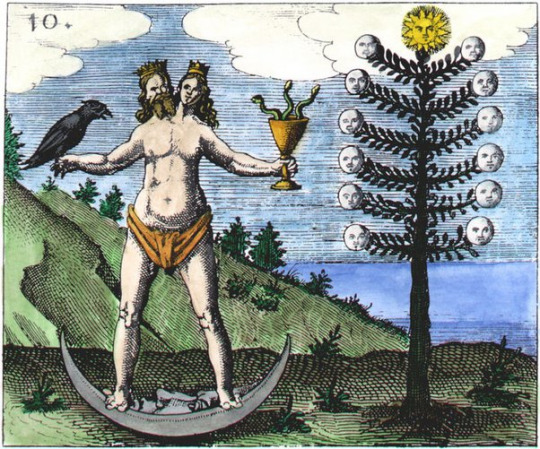
From Rosarium Philosophorum, redesigned by Johann Daniel Mylius
Angel: The volatile, spiritual, subtle matter of the Stone during sublimation.
Antimony: The substance of the Stone during the nigredo, black earth, the next stage up from lead.
Apollo: Represents the Red Tincture. The masculine principle, hot and dry, the rubedo stage.
Apple: The golden apple represents the fixing power of Sulphur on the elusive Mercury (represented by Atalanta).
Aqua ardens: “Burning water,” the universal solvent that dissolves matter into prima materia. Represented by Mercury.
Aqua regia: “Royal water,” a mixture of nitric acid and hydrochloric acid (sal ammoniac) that can dissolve gold and platinum. That makes it a form of the mercurial “burning water” that can reduce all metal to prima materia.
Aqua vitae: Ethanol, specifically distilled wine. It’s also a name for Mercury and for Quintessence, the catalyst of the work that “washes” the matter of the Stone to purify and whiten it. It’s the “water of life” that resurrects the dead matter, the essence of love and forgiveness.
Argent vive: Quicksilver, actual mercury (Hg), the feminine “seed” of metals that must be “married” to its masculine counterpart, sulfur.
Ash: The remains of the body when the subtle self (the soul) is removed during calcination. It is the white powder that the body becomes during the white stage, which is washed in mercurial water and tempered with fire. A phoenix rises from the ashes.
Autumn: The completion of the Great Work is symbolized by the philosophical tree bearing its gold and silver fruit. Trees bear fruit in autumn, making autumn the season of culmination.
Balm: A term for the Philosopher’s Stone in the form of a panacea, a medicine that can purify anything and cure any disease (including spiritual ones)
Basilisk: Mercury in its negative aspect, it represents endless hunger and self-absorption. It is the mercurial water in its destructive aspect, which “kills” base metal, reducing it to prima materia.
Bath: The mercurial waters of purification, which dissolves, cleanses, and resurrects the matter of the Stone. The breaking down and washing away of an old state of being, leading to rebirth; baptism.
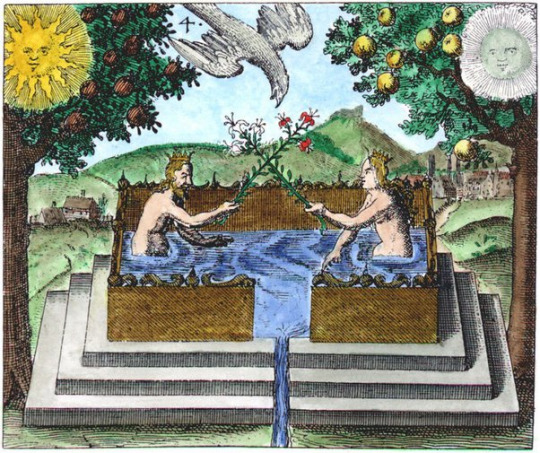
From Philosophia Reformata by Johann Daniel Mylius
Battles: Between a god and a dragon, or two dragons, or an eagle and a snake, a lion and a winged lioness, or similar; represent the alchemical lovers (Sol and Luna) in their impure state, as the “quarrelling couple.” Their fighting represents the violent chemical reactions that result of trying to force together the opposing forces of sulfur and mercury (or of the four elements), but eventually they reconcile and are married.

By Johann Daniel Mylius
Bed: The alchemical vessel during the “chemical wedding” stage.
Bee: Another symbol of the “mercurial serpent,” universal solvent. Its sting is a version of “killing” metals, destroying the old state of being. (Bees also transmute base matter in their process of creating honey.)
Beheading: The dismemberment of the King, the dissolution stage, leading to putrefaction and nigredo. It frees the soul from the body, so it can gain spiritual understanding. (The 8th engraving in The Ninth Gate.)
Binding: Binding Mercurius with cords represents fixation of the volatile, controlling the elusive and wily spirit of Mercurius so that he will help the alchemist. Nailing a serpent to a cross means the same thing.
Birds (flying): Represent volatile substances—vapors, fumes, spirits, souls, rising to the top of the alembic and falling as rain during the ablution stage.
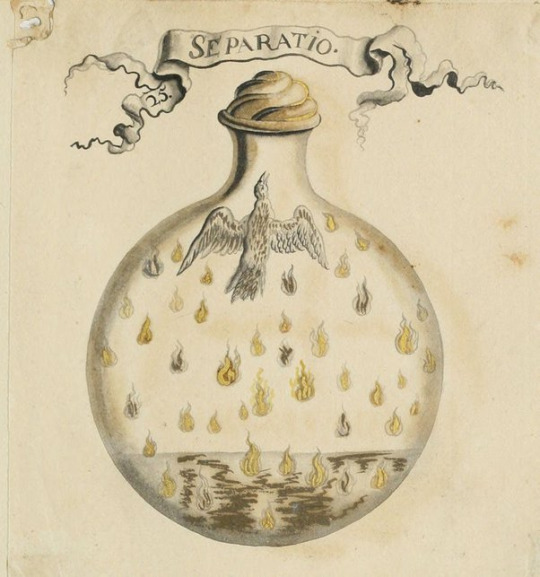
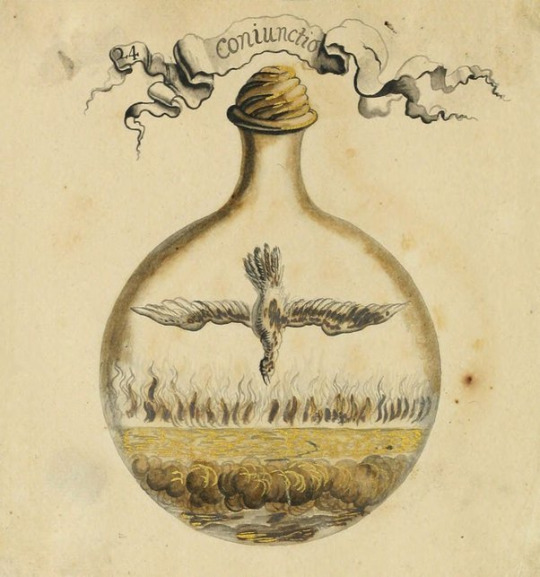
From The Crowning of Nature
Birds of Prey: The “amorous” birds of prey are a particularly violent symbol of the Chemical Wedding, the uniting of substances. They simultaneously copulate and cannibalize each other. Consumption represents taking the essence of the consumed into oneself, such as in communion or in the ouroboros symbol.
Bird of Hermes: A symbol of the Philosopher’s Stone, which must be hatched from an egg produced by the Chemical Wedding, raised, and tamed. It eats its own wings, representing the fixation of the volatile (i.e. it can no longer fly upwards). Its blood is the Elixir of Life.
Black: The nigredo, the death of the old state of being and the mortification of the body that paves the way for renewal and resurrection. The matter of the Stone during the nigredo is called “black earth,” and it lies at the bottom of the alembic. The soul descends into the Underworld and experiences the Dark Night of the Soul, and all the difficulty and pain that come with it. Symbolized by the crow or raven, the grave or tomb, the eclipse, beheading, coal, lead, and Saturn.
Blood: A symbol of the Red Tincture, the Philosopher’s Stone. If a “pure” being sheds blood, it cleanses “impure” beings of corruption. It is also the mercurial water that washes the matter of the Stone during ablution. The blood of the Green Lion nourishes the Stone during cibation. Staining white sheets with red blood (i.e. as in the loss of virginity, the gaining of sexual maturity) represents the rubedo following albedo.
Bronze/Brass: Both represent “white gold” (gold + silver), the raw matter of the Stone which must be cleansed of impurities. Identified with Latona (Leto), the mother of Apollo and Artemis (i.e. the sun and moon), and also with the Green Lion. It must have its “stains” washed away to become Gold and Silver (respectively).
Caduceus: The wand of Hermes, symbolizing the circulation of male and female energies (the serpents), and their reconciliation. The wand unifies them, and they entwine around it. Harmonizing unification of all opposites.
Calcination: Stage One. Heating the base metal to ash. This represents removing all the surface qualities of the self, putting oneself through “purifying fires” until one is reduced to prima materia. Self-judgement, acknowledging that you are not perfect, with a desire and determination to do better. Burn away the old self.
Castle: The alchemical vessel, sealed to prevent the substance of the Stone from being contaminated by outside forces, and to keep the volatile part from escaping. Its towers represent the athanor (furnace). The castle can also represent “impure” matter (i.e. the Green Lion, Latona). Also represents withdrawing to the inner self.
Chaos: The formless matter from which the world was made, the mass of prima materia at the beginning of the universe that contains all things, and from which all things come. The extremely dense ball of matter that was the universe until the Big Bang. Chaos is separated into the Four Elements, which are then united with each other in harmony.
Chariot of Phaethon: A name for the Great Work. This is because the Opus is cyclical like the wheels of a chariot and the sun’s course through the heavens. When Phaethon dies, Helios mourns in the form of an eclipse, representing the nigredo.
Chemical Wedding: The image of lovers, usually a king and queen representing the sun and moon, being married or having sex. One of the most important parts of the Work, the unification of opposites — sulfur and mercury, male and female, sun and moon, hot and cold, dry and moist, fixed and volatile, body and spirit. The lovers are wedded by Mercurius, the mediating principle who binds them together. The chemical wedding happens multiple times, becoming more “purified” each time – it begins as animals mating, and ends as the noble royal wedding of the King and Queen. The resulting Stone is the essence of pure divine love. Coagula is always followed by solve again, so often the lovers are shown in a coffin or grave, because the nigredo follows the chemical wedding. After that happens, soul and spirit unite in the albedo stage, and then they reunite with the now washed and purified body in the rubedo stage. Body dissolves into spirit, spirit coagulates into matter. Therefore, the knowledge gained from union with spirit (God) can be actively applied and made manifest in the physical world.
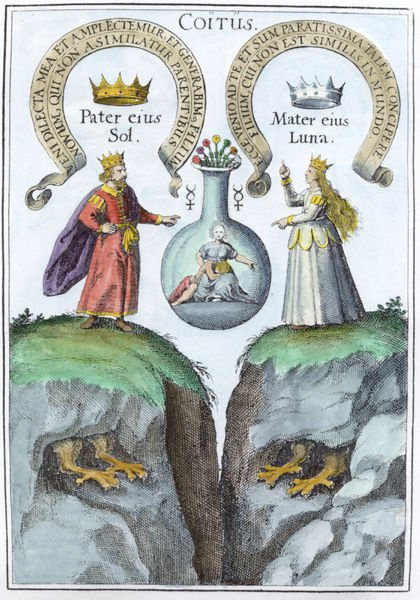
By Johann Daniel Mylius
Child: The Philosopher’s Stone when it is born from the chemical wedding of the Sun and Moon. He gestates in the belly of the wind, i.e. the soul in the volatile state. When he is brought to Earth and nourished, he grows up to be a spiritual tour-de-force that can raise the vibration of anything.
Child’s play: Another metaphor for the Opus, because the process is subversive, and because it’s stupidly simple once you actually understand how it works. The Opus is compared to making mud pies by pouring water on dust and then making “solid” objects with the resulting mud.
Cibation: Stage Seven. The newborn Stone is “fed” the White and Red Tincture, “milk and meat,” which are added to the vessel to re-infuse the Stone with life energy.
Cinnabar: Mercury sulfide (ore), which is bright red. Represents the color of the Stone in the final stages.
Circle: Perfection and eternity, the spiritual realm, the completed Work. With a dot in the center, it symbolizes gold.
Cloud: The vapor that rises to the top of the vessel during sublimation, the volatile state. The cloud is dark and made of argent vive (quicksilver), eclipsing the sun. During distillation, the cloud condenses into rain, which “washes” the stone during ablution.
Coal: Represents the nigredo, the black stage, the dead matter of the Stone.
Congelation: Fixation, crystallization, or freezing, the conversion of liquid into a solid state. Fixing the volatile spirit.
Conjunction: Steady, level heating of the mixture. Represents reconciling the polarized self, the first step towards integration of the Shadow. The “sacred marriage” or “chemical wedding” between mercury and sulfur unites them back into the same whole. Unification of opposites. The darkness becomes conscious. Coming to terms with oneself, self-acceptance, integration.
Copper: Metal that is almost perfect, but not quite. The state of being nearest to Gold; gold that still has a bit of darkness on it. It is still impure and not quite fixed. Once it “becomes shadowless,” it is Gold. Symbolized by Venus.
Coral: Represents the Red Stone, which grows in the mercurial water as coral lives in the ocean. Also represents the philosophical tree.
Cream: The white stage, albedo. After the chemical wedding, the souls of the dead king and queen rise to the top of the vessel the same way cream rises to the top.
Crocodile: The Mercurial Serpent in its most base and chthonic state, when it is dark and destructive.
Cross: A combination of the “passive” (horizontal line) and “active” (vertical line) forces of the feminine and masculine (respectively). Therefore, the synthesis of the male and female principles and the resulting unity of the volatile and the fixed. Also the four elements (clockwise from top: fire, air, earth, water) and Quintessence, the central point. (The hexagram has identical symbolism, being a combination of the signs for all four elements.)
Crow: The putrefaction stage, the nigredo or black stage that begins the work. The matter of the Stone is dissolved into prima materia and dies, so that it can be reborn.
Crown: A symbol of the spiritual perfection of the completed Philosopher’s Stone, which is represented as a king. The crown is a representation of the halo of light around the head of an enlightened person. The loftiness of alchemy is presented in regal terms – alchemy is called “the royal art,” gold the “noble metal,” and the final union of the male and female principles is the “royal wedding” between the philosophical King and Queen.
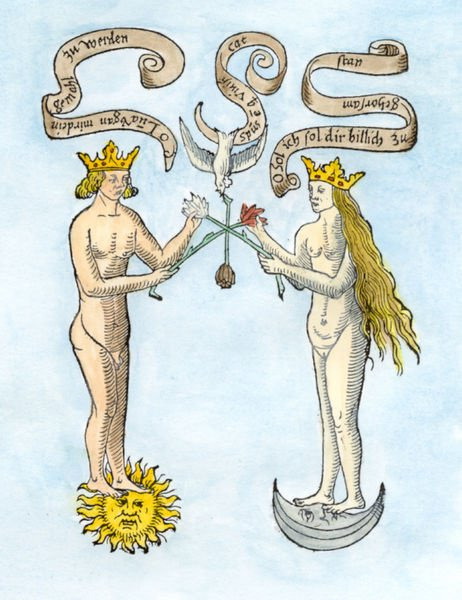
From the Rosarium Philosophorum
Crystal: A synonym for the Philosopher’s Stone at both the white and the red stage. Crystallization is also a word for coagulation, fixing the volatile.
Cupid: Another name for Mercurius in the form of “secret fire” or “burning water.” Cupid’s arrows of passion represent the universal solvent that reduces all substances to prima materia. The essence of love in the arrows refers to the higher nature of the Stone/elixir. Also a symbol of Mercurius as the mediator in the Chemical Wedding, who marries Sol and Luna.
Dawn: Represents the albedo stage, because the light of dawn is pale like moonlight, and it is followed by the blazing risen sun that represents the rubedo stage.
Decoction: Heating an ore or mineral, also extraction of the liquid essence of a substance by boiling.
Death: The nigredo stage of the Opus, during which soul is separated from the body and the body putrefies or is dissolved. Represents unenlightened consciousness and the rejection of the mundane self, being freed from the confines of one’s earthly body. An alchemist must metaphorically cast off the mortal coil without physically dying. Death is like a gate on a circlular path. You have to go through the gate, or you will never be able to continue around the circle. You’ll just stay stuck in place. To become immortal and continue forever around the circle, you must die, and cannot fear death.

From the Twelve Keys of Basil Valentine
Deer: Represents the soul. The “fleeing hart” represents Mercurius, specifically the flightiness of Mercurius, and also his role as the messenger and mediator between body and spirit. He is both a faithful servant (i.e. “servus/cervus,” deer) and an elusive and deceptive enigma that must be captured by the alchemist. According to Paracelsus, its antlers heal wounds.
Den: A word for the vessel during the nigredo — the serpent’s or dragon’s den, or spirits’ den.
Devil: A symbol of sulfur.
Devour: If animals or people devour each other, it usually represents an opposing state overcoming the other — such as the volatile (a winged creature) overcoming the fixed (the other animal), Saturn devouring the divine (mercurial) child, etc. Devouring is often a representation of solve, one substance or state being consumed by the other, but it’s also coagula in that it unites the fixed and volatile. The animals can also represent the earthly nature of man being destroyed. Something must die for a newer and purer thing to exist. Sometimes devouring is a metaphor for sex, a particularly violent rendition of the chemical wedding. It’s violent to symbolize the intense opposition of the substances.
Dew/Rain: The healing aspect of mercurial water. The blackened, putrefied matter of the Stone is washed in the dew and turns white (ablution). The dew falls like rain from the celestial spheres and reanimates the dead matter. “It ascends from the earth to the heaven and again it descends to the earth.” Precedes the second chemical wedding, when the purified soul is reunited with the body.
Diana: The matter of the Stone in the white stage, the White Tincture, the female principle, argent vive.
Dissolution: Stage Two. Dissolving the powder in (mercurial) water made from the condensed vapours from calcination. This represents self-awareness, dissolving your prejudices and old patterns, understanding the psychological roots of your behaviors. The first stage of Shadow work. Returning to the Abyss, the primordial waters, again and again and again. Purification by water.
Distillation and Sublimation: Stage Five. The process in which the volatile spirit is extracted from the impure body. It vaporizes (sublimates) and then condenses. Metaphysically, it’s katabasis, the necessary descent of the soul into base matter – “the way down is the way up.” You can’t ascend without having descended first. What Goes Down Must Come Up.
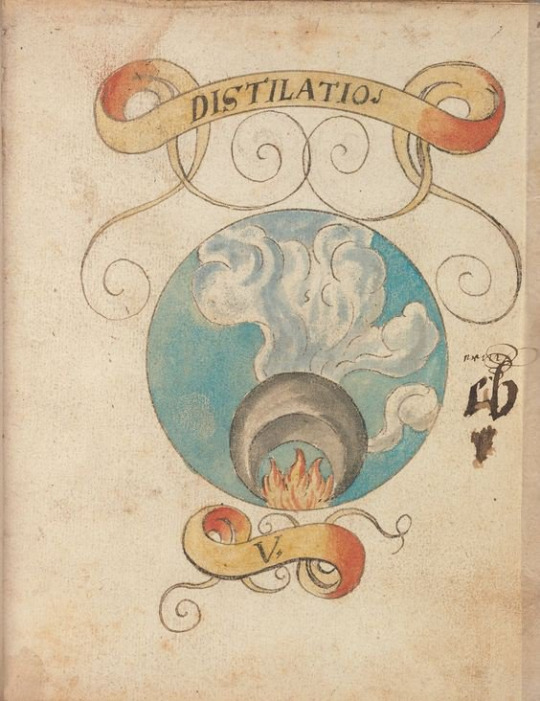
From The Crowning of Nature
Dog: A male dog represents sulfur while a female dog represents quicksilver. Two dogs having sex represents the most “primitive” form of the Chemical Wedding (which can also be represented by copulating dragons or lions).
Dove: A symbol of the albedo, the white stage, and purity following corruption. Also a symbol of Mercurius as the mediating force in the Chemical Wedding, uniting the forces of sulfur and quicksilver.
Dragon: Mercurius in his chthonic aspect as prima materia. Two dragons, one winged and one wingless, represent quicksilver and sulfur (respectively). They copulate, then kill and devour each other, then are entwined together around the caduceus in unity. Mercurial water is called “dragon’s blood” in its aspect as a universal solvent. It is the dragon that guards its horde of gold in the Abyss of a cave .The dragon represents the “base” self that the higher self must tame, represented by the dragon being slain by a solar hero (Apollo, Marduk, Siegfried, Beowulf, Harry Potter, etc.).
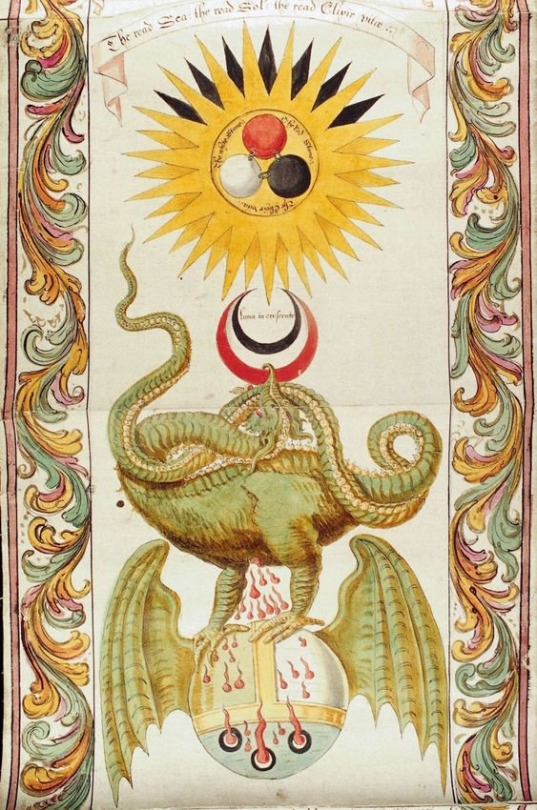
From The Ripley Scroll
Dregs: The impurities of the Stone that are left behind during dissolution and sublimation, that sink to the bottom of the vessel.
Dust: The purified body of the Stone during the albedo stage, which collects on the sides of the vessel through sublimation. (Also called ash, snow, or white foliated earth.)
Dye: A metaphor for the white stone turning red or purple. The Stone is “washed” in the Red Tincture, like dying cloth. Tyrian purple in particular is a metaphor for eternal spiritual perfection, because it is a permanent dye and rare. The Stone being stained with blood is the same metaphor.
Eagle: The White Tincture, another symbol of Mercurius during the albedo stage after sublimation. When paired with the lion, the lion represents the fixed state and the eagle represents the volatile state — if the eagle devours the lion, it’s a symbol of solve. The lion is devoured by the eagle to make it spiritual, and the eagle’s wings are clipped to make it corporeal.
Earth: Corporeality, the physical world, stagnation, fixation. The dense body of the Stone, represented by Saturn. (We live in the physical world, so the other elements are not their “true” selves, but perceived as correspondences that symbolize their true selves “through” the Earth element. It allows the other elements to “rest.”) Its properties are cold and dry.
East and West: Respectively, sulfur and quicksilver. Sulfur is dry and hot, quicksilver is cold and moist.
Eclipse: The solar eclipse represents the nigredo, when the impure matter of the Stone putrefies, death preceding rebirth. Described as a “black gate” that sulfur and quicksilver must pass through. The moon “dissolves” the sun. Symbolized by the Green Lion devouring the sun. (Also called sol niger. For the lunar eclipse, see sun and shadow)
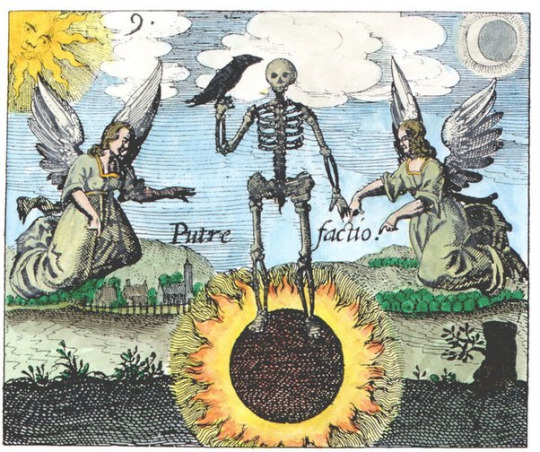
From Philosophia Reformata, by Johann Daniel Mylius.
Egg: The vessel. Hatching of an egg is a metaphor for the creation of the Stone. The fire of the athanor is like a mother bird incubating her eggs.
Elements: Earth, Air, Fire, and Water. The Philosopher’s Stone must be made of all four elements in the right amounts to produce the perfect fifth element, Quintessence. Earth is cold and dry, Water is cold and wet, Air is hot and wet, and Fire is hot and dry. Earth can be mixed with water because they are both cold, Water can mix with Air because they are both wet, and then Air can mix with Fire because they are both hot.
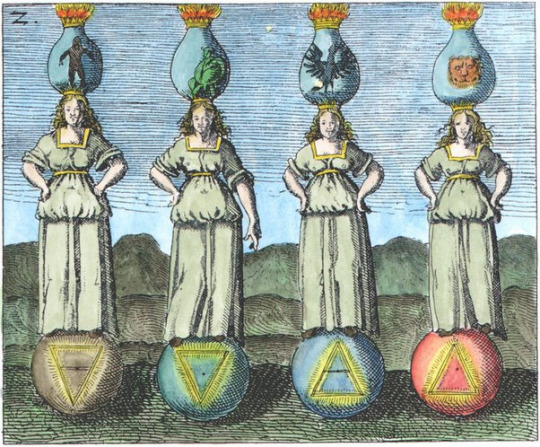
From the Viridarium chymicum
Elysium: A name for the white stage, a pure and beautiful garden of symbolic plants that immediately follows death.
Eyes: The rainbow “peacock’s tail” stage between nigredo and albedo.
Exaltation: Stage Eight. The material turns red, with all of its components fusing into one whole and becoming stable in the most intense heat of the furnace. The Stone has appeared. Once the ecstasy peaks, the body, soul, and spirit permanently fuse. Also called Fixation.
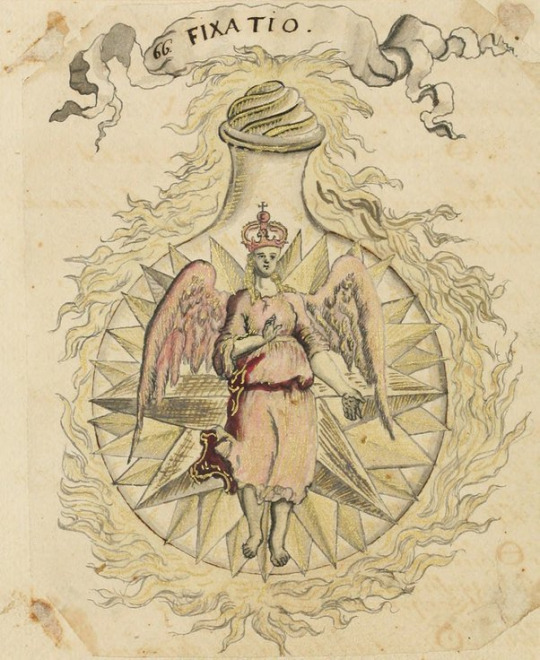
From The Crowning of Nature
Feathers: A bird eating its feathers symbolizes the dissolution that occurs after the chemical wedding (also symbolized by a child playing in a bath), Also a symbol of the “peacock’s tail” stage.
Fermentation: Stage Six. Permanently infusing life force into dead matter. The spiritual and base aspects of the self are united, and one is freed from superficial or “worldly” desires and concerns. The enzymes that cause fermentation represent the soul “quickening” the body. The material turns yellow and becomes gold. Add some gold to it to facilitate this change, like putting seeds into the earth. “Intoxicated surrender to one’s true inner self” (Richard Cavendish), seething emotions and ecstasy.
Field: Potential, the potential to “cultivate” the philosopher’s stone, in which the “seed” of the soul is sewn to be transformed into its realized potential, the flower. This happens through the course of the seasons—winter (black), spring (clear/white), summer (red), and autumn (gold).
Fire: The element, the essence of divine love, which causes transmutation. It is hot and dry, and inherently spiritual, a sort of microcosm of the Sun. The “secret fire” is purifying and transformative. The heat and intensity of the fire in the athanor increases as the Work progresses through the stages. Also represents the Divine Masculine. Symbolized by the Sun and Gold. In its impure form, as sulfur, fire is also individualization and the ego, which becomes consuming and desirous. Often conflated with mercurial water/argent vive, which “burns” and dissolves things.
Flood: Dissolution and putrefaction, with Noah’s Arc or a similar boat symbolizing the Vessel. The waters of the deluge drown and destroy everything, until they suddenly transform into the waters of life. The rainbow that follows the Flood is the Peacock’s Tail.
Flowers: Fully realized potential, resurrection, exaltation, rising from the depths of the Earth. (The stem is virile, the flower itself is elemental.) The rose in particular has mostly the same symbolism as the cross. Also a word for the powdery version of the body that is a result of sublimation. Also a symbol of the Philosopher’s Stone, the perfect substance. Flowers bloom as a result of Earth, Water (rain), and Fire (sunlight). White roses or lilies symbolize the albedo, golden flowers symbolize citrinitas, and red roses symbolize the rubedo.
Fountain: Purifying mercurial water, that generates all other metals. Same symbolism as the bath.
Fruit: Raw gold before it is transmuted into the Philosopher’s Stone. If the fruit putrefies in the ground, then its seeds will sprout into new trees. The Philosophical Tree bears gold and silver fruit representing the Sun and Moon. Bearing the fruit is a symbol of increasing spiritual awareness, and eating the fruit represents gaining that spiritual knowledge. Sometimes the golden fruit is specifically the Apples of the Hesperides, guarded by the dragon.

From Compendium Alchemyst by Johann Michael Faust
Furnace: The athanor in which the alembic or Vessel is heated. It contains “philosophical fire” (the soul), which purifies the matter in the Vessel. It causes suffering but also removes impurities. You have to suffer in the fire to be cleansed, and rise from it like the phoenix.
Garden: The Vessel, in which the philosophical tree grows. Sometimes also a rose garden, with red and white roses. The blooming of the roses represents the attainment of spiritual wisdom.
Glass: The Vessel. When the alchemical couple (Sol and Luna, or sulfur and quicksilver) die and enter the putrefaction stage, they are “shut in a glass.” The vessel can be symbolized as a glass house, glass prison, or glass coffin. Making glass is also a metaphor for the fixation process, because the volatile liquid crystallizes into hard glass.
Glue: The medium by which Sol and Luna are joined together during conjunction, that which officiates their Chemical Wedding. A form of Mercurius, the mediating soul that unites the body and spirit. Usually symbolized as a dove. Also symbolized as gum or resin from the philosophical tree.
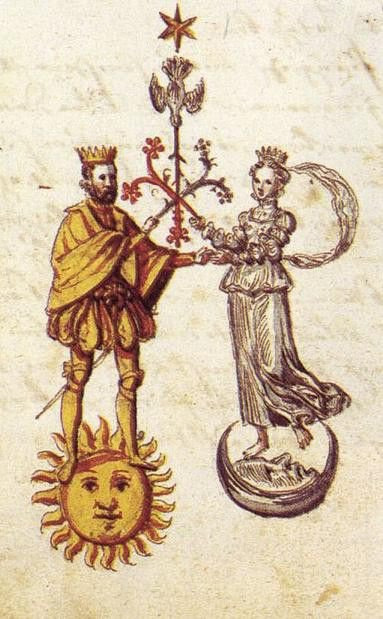
From the Rosarium Philosophorum
Gold: A pure, condensed form of the solar force and the Divine Masculine, and the ultimate goal of alchemy, representing spiritual perfection. It is the microcosmic Sun. It can “endure the trials of fire” (i.e. it has a low boiling point). All metals were thought to contain the potential to “ripen” into it, under the right conditions. Figuratively, this means that all people have the potential to become pure spiritual beings. The golden soul is one that has died and been resurrected as a purer thing, whose spirit has become fixed, and who has therefore attained a kind of earthly divinity.
Golden Fleece: A symbol of the Philosopher’s Stone. The quest for the golden fleece represents the alchemists’ quest for the Stone. Also a term for a supposed book made of sheep vellum that details all the secrets of the Great Work.
Grain: A term for the “seed” of metals, which grows into Sol and Luna (gold and silver). The Stone is also compared to grain or corn that has to “die” before it can bear fruit. “Purple grain” is the Red Tincture.
Grapes: Prima materia, the raw material of the Stone. Grape juice or wine represents the mercurial water of dissolution. A grapevine can also represent the philosophical tree, with the red fruit being the Philosopher’s Stone.
Grave: The Vessel during the nigredo stage, when the matter of the stone dies and putrefies. The dead bodies of the alchemical lovers are shown in a tomb or coffin.
Green: The color of the maturing Stone, after it has been born. It is the color of fertility and growth, so it represents the Stone’s capability to multiply itself and cause the “seeds” of metals to “mature” into gold and silver. It also represents the generation of the Stone after the Chemical Wedding.
Green Lion: Raw antimony ore (stibnite), “unclean” or “impure” material of the Philosopher’s Stone. Prima materia at the earliest stage of the Opus. The volatile mercury (spirit) is extracted from it. Associated with Latona (Leto, from whom Apollo and Diana as the Sun and Moon are born). It is green because the vital essence of fecundity comes from it, but also because it is an early and “immature” form of the Stone (like unripe fruit). Represents Mercurius in its form as a solvent: the lion eats the Sun, causing the nigredo and dissolution. After it is dissolved into prima materia, the “seed” can grow. The Green Lion also represents Mercurius as the “glue” that marries the Sun and Moon.
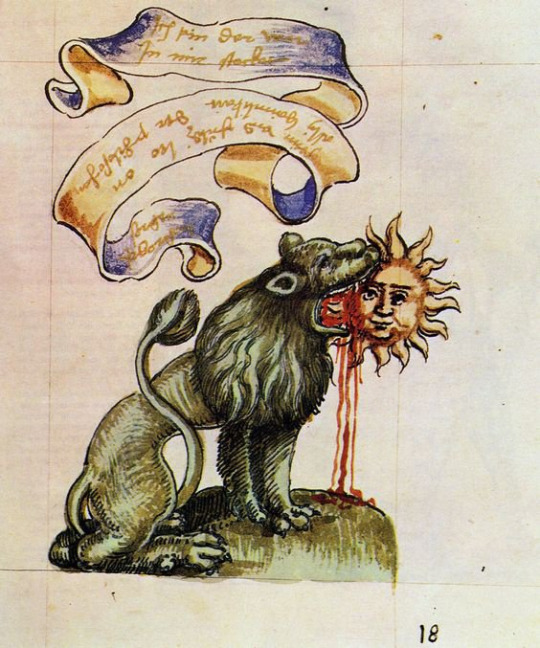
From the Rosarium Philosophorum
Griffin: A symbol of argent vive/quicksilver, the female principle. The feminine equivalent of the red lion. They fight each other, symbolizing the Chemical Wedding at its most early stage. (Combines the volatile eagle with the earthly lion.)
Halcyon (Kingfisher): A symbol for philosophical mercury, which is supposed to be sky blue. It is a universal solvent, able to destroy and then revitalize anything.
Harvest: The completion of the Opus and attainment of the Stone. The Great Work is often compared to the cultivation of a tree or a flower.
Head: The vessel or alembic, also symbolized by a helm. The vessel itself is a metaphor for the human body, and the real transmutation takes place in one’s head (i.e. mind). A person with black feet, a white body, and a red head is a symbol of the Opus. A severed head is a symbol of nigredo and dissolution, the separation of the soul from the body.
Heaven: The subtle matter of the Stone, the volatile vapor at the top of the alembic (as opposed to the “white foliated earth” at the bottom). “It ascends from the earth to the heaven and again it descends to the earth.” Quintessence is also called “heaven” because it is a perfect substance and it is bright blue.
Hell: The black matter of the Stone during the putrefaction stage, which is destroyed by fire (or “secret fire,” mercurial water). This stage is the descent into the Underworld or Tartarus.
Hermes’ Seal: The seal made of a special clay that keeps the alchemical vessel closed and airtight. The sealed vessel functions as an isolated cave or sanctuary in which one can seek enlightenment.
Hermes’ Tree: The philosophical tree, which must be tended by the alchemist and nourished with mercurial waters and then harvested. Another symbol for the Philosopher’s Stone.
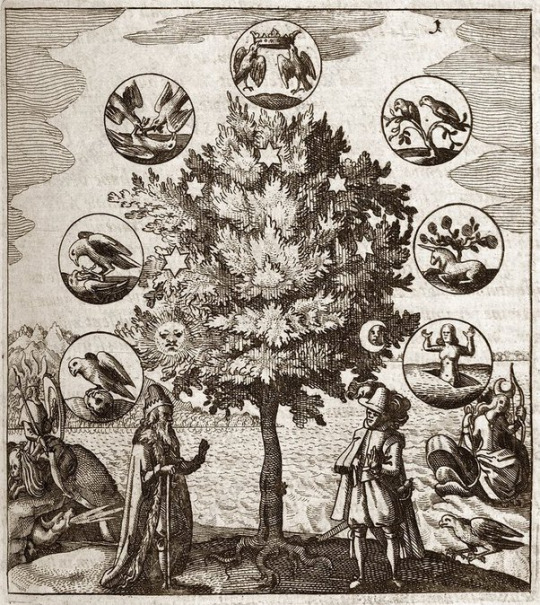
From Philosophia Reformata, by Johann Daniel Mylius
Hermes Trismegistus: The legendary inventor of alchemy, said to be an incarnation of both Hermes and Thoth. Called “thrice-great” because he was a king, a mage, and a priest. Said to have written the Emerald Tablet and the Corpus Hermeticum.
Hesperides: The garden in which the philosophical tree grows. The Golden Apples of the Hesperides are another symbol for the Philosopher’s Stone.
Homunculus: An artificial human created in an alembic. Also a symbol of the Philosopher’s Stone in its infantile state. Represents the birth of the divine child inside one’s own soul. The Stone is figuratively a “baby” that must be gestated and raised, both in the alembic and spiritually in one’s soul. (i.e. You are reproducing God’s creation of yourself in a microcosm.)
Honey: Another name of mercurial water, in its aspect as a healing agent instead of a “burning” solvent. A symbol of the Elixir of Life and the panacea, because it is a sweet gold liquid.
House: The Vessel. It’s made of glass, shaped like the squared circle, and “sweats” (condensation).
Inversion: Alchemy constantly involves reversal — flipping between states of matter, releasing the soul from the body and then bringing it back down into the body, dissolving a substance down into prima materia and then reforming it. Descend before you can ascend, go backwards to go forwards. As above, so below. This is why Mercurius is dual-natured.
Inverted tree: The upside-down philosophical tree has its roots in heaven, which means that its nourishment comes from the Divine (Mercurius), and it “returns” to the earth.
Iron: Represents Mars, action, virility, and violence. If one can separate the virile warrior component from its corporeality, it can become Gold. Iron is “fixed” Sulfur. When treated by Water (female principle) and Fire (male principle), it becomes “purer” Steel. The production of steel is therefore a microcosm of the Great Work.
Jackdaw: Being a corvid, it’s another symbol for the nigredo stage, death and passage through hell.
Jupiter: Represents the metal tin, and the color gray. Tin is “imperfect” but takes only a little bit of work to become perfect (i.e. turn to gold). Also represents fire as in actual fire (not “secret” or “philosophical” fire). Zeus bringing Ganymede to Olympus in the form of an eagle represents sublimation. He also turns into a shower of gold to visit Danae — Jupiter easily turns to gold.
King: The matter of the Stone, as well as the hot and dry male principle — sulfur in its impure state, gold in its pure state. He is the Sun, and must be “married” to his female counterpart, who represents mercury and the Moon. He represents the conscience and the Divine Masculine. The King is both the philosophical child and its father (implied to be the same being). He dies and then is resurrected. His drowning in the ocean or a bath is a symbol of dissolution, followed by a gentler washing of his body, then he is married to the Queen. The resulting child is the Philosopher’s Stone, who also grows up to become a King.
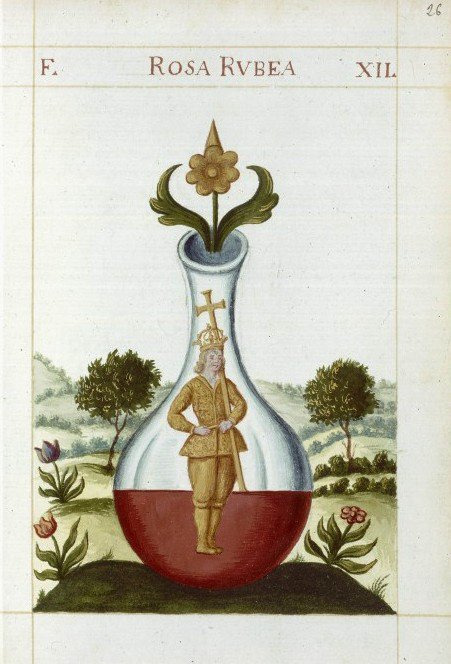
From Pretiosissimum Donum Dei
Labyrinth: The dangerous and confusing process of the Great Work. The labyrinth is full of illusions, and only with divine inspiration can one make one’s way through.
Latona: An imperfect or impure version of the Philosopher’s Stone, represented by bronze or brass (or copper). Similar in nature to the Green Lion. The blackened body of the stone preceding the albedo stage, that must be washed to remove its impurities. She is both metallic ore and the bowels of the earth from which it comes. (The name “Latona” comes from Leto, the mother of Apollo and Artemis, i.e. the mother of gold and silver.)
Laundry: Ablution, washing the Stone to cleanse it of its impurities during the white stage. The stained sheets represent the impure matter, which must be washed so that they will turn pure white. (When the sheets are later dyed red or purple, it represents the rubedo.)
Lead: Prima materia, the raw material that is made into the Philosopher’s Stone and also transmuted by it. The former is “philosophical lead,” the matter of the Stone during the nigredo stage. Represented by Saturn, who can be interpreted as an “aged” Mercurius. White lead is “purified” lead in the albedo stage. Symbolizes the chaotic and melancholic state of the soul after having been separated from itself. (also called Adrop)
Leprosy: The “imperfection” of metals, i.e. lead, copper, tin, and iron are just “diseased” gold and silver. They need “medicine” in the form of the panacea or Philosopher’s Stone. (also called rust)
Lily: The White Tincture and White Stone, the matter of the Stone during the albedo stage. Symbol of purity, perfection, the Moon, and the female principle. Therefore it also represents silver, quicksilver, and Luna/the Queen. It’s paired with a red rose, which represents the male principle. (A white rose symbolizes the same things.)
Lotus: A circular flower with a vertical stalk on horizontal water, therefore the same meaning as the ankh symbol—life, rebirth, resurrection, eternity.
Lute: A kind of clay used to seal the vessel/alembic. It’s made of various things — glue, flower, herbs, honey, egg whites, wax, resin, vitriol…
Magistery/Magisterium: A name for the Great Work. Means literally, “quality of mastery.”
Magnesia: Refers to several substances, all symbols for Terra Alba, “white foliated earth.” Also a name for Mercurius in the form of Quintessence.
Marble: A symbol of the White Stone, which is acquired during the albedo state.
Mars: Represents the metal iron, and the color red. Follows Venus in the Opus, and is associated with the “peacock’s tail” stage. He symbolizes the violent, impure form of the Divine Masculine, symbolized by the Red Lion.
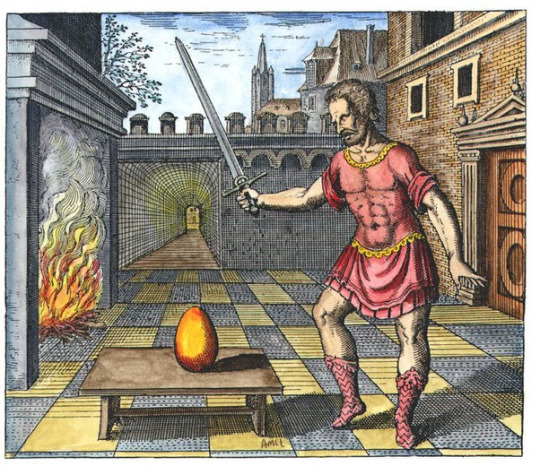
From Atalanta Fugiens
Medicine: The Philosopher’s Stone in the form of a panacea. It can supposedly cure any disease, and also transmute “diseased” metals (copper, iron, tin, lead) into gold and silver. The idea of a panacea is more metaphorical, curing “diseases” of the soul and transforming human beings into enlightened and divine versions of themselves. In short, it raises the vibration of anything it comes in contact with.
Melancholia: The state of mind that accompanies the suffering of the nigredo stage. It is the initial terror and sadness that you experience upon confronting your Shadow. You end up in the “nox profunda,” the deep night or dark night of the soul, a dark pit of the Underworld which it feels like you will never escape.
Menstruum: Mercurial water, the universal solvent. Called the “blood of the green lion.”
Mercurial water: The universal solvent, which dissolves metals and other matter into the prima materia. Symbolized by a lion or a serpent, and also by water (floods, dew, fountains, rain, tears, the ocean). It first “burns” and destroys everything to “kill” the old state of being, but then transforms into the water of life, washes and revitalizes it. (also called alkahest)
Mercurius: The ultimate agent of transmutation, the purified prima materia and the divine spirit within matter. Both the Philosopher’s Stone, and the Opus that produces it. Sometimes Mercury is described as “philosophical water,” or as fire, or as air or vapor (spirit, soul). It is prima materia, the source of metals, and also their potential to turn to gold. It is the primordial “mother” of the Philosopher’s Stone and also the child, the Stone itself. It is self-begotten, self-generative, self-destroying (i.e. the ouroboros). It is the universal solvent of death, and the animating force of life. Hermes is dual-natured and a synthesis of all opposites. He is both light and dark (i.e. celestial and chthonic) and is not tainted or corrupted by his engagement with darkness. He dissolves and coagulates, creates and destroys, kills and revives. He is an elusive trickster, but also a helpful ally. Alchemical Mercury is also a hermaphrodite, both male and female. Mercury is the spirit that unites body and soul, and weds the Red King and White Queen. Since Hermes is the messenger god who transfers information between the human and the divine, and brings the soul between life and death, he is also a mediator between the mundane self and the Higher Self. Mercurius is also a summary of the entire alchemical process. “Binding Hermes” means making his volatile nature, fixed. First he is the dragon or serpent, then the green lion, then the white eagle. Finally, Hermes’ association with commerce relates to the alchemical production of gold. (Also called Azoth, aqua divina, aqua permanens, aqua regia, aqua ardens, aqua vitae) (Note: Mercurius represents the Stone, not actual mercury. For actual mercury, see quicksilver.)

From the Twelve Keys of Basil Valentine
Metamorphosis: A word for transmutation, changing states of matter or states of being. Also, Ovid’s Metamorphoses were referred to as analogies for the Opus by alchemists.
Milk: The pure and spiritual version of mercurial water, extracted from the green lion ore. The White Tincture, which can transmute metal into silver. It nourishes the baby Philosopher’s Stone during the cibation stage.
Mirror: “Divine Spirit,” observing the self, becoming the most divine version of oneself through self-observation and Shadow work.
Moon: Silver and quicksilver/argent vive (actual mercury), the female principle. Also the White Tincture and White Stone in the albedo stage. Luna is married to Sol, the King. Her properties are cold, moist, and receptive to his hot, dry, and active. She is the Divine Feminine, and represents, the imagination, dreams, emotions, intuition, the subconscious, the changeable and volatile, the energetic, the soul. The subconscious is “cleansed” during the white stage. Cold moonlight represents the half-enlightened conscience of the albedo stage. Associated with solve, dissolution, making the mundane spiritual.
Mountains: A symbol for the source of prima materia. To obtain it, the alchemist must climb a mountain and extract the juice of a magic herb that grows on it. Sometimes there’s two mountains, one for the masculine “seed” and one for the feminine one. Going into the mountains can also be a metaphor for isolating oneself to gain spiritual awareness.
Multiplication: Stage Nine. Another sacred marriage/copulation between the Red King and the White Queen, so the Stone can become “fertile.” The Opus repeats itself again and again in rapid succession, with the Stone constantly dissolving and coagulating to create more of itself.
Nest: The Vessel, as a container for the “egg” or “chick” of the Bird of Hermes.
Night: The nigredo, the first stage of the Opus. It’s the Dark Night of the Soul in which the body dies and putrefies, and then is dissolved. The soul experiences a descent into the Underworld.
Oak: The philosophical tree. Also the vessel or athanor, when hollow.
Orphan: The Philosopher’s Stone, because its “parents” (the King and Queen. Sol and Luna) must die so it can be born. The alchemist becomes its foster parent and raises it in their place.
“Our” [substance]: Alchemists use the word “our” to refer to spiritual/metaphysical symbols represented by substances. So, “our mercury” isn’t Hg, it’s the feminine principle of nature. “Our sulfur” is the masculine principle of nature. “Our gold” is the perfect state of being, and not actual gold, Au. “Our [symbol]” refers to the metaphorical thing the symbol represents, not the symbol itself. It was never about making actual gold. If you think it is, you’re missing the point.
Ouroboros: The universe and the Great Work. The Ouroboros is and encircles all things, and thus represents the Principal of Mentalism. It is the circle of life — life returns to that which generated it, and supports other life. It creates itself, and also destroys itself (since it bites its own tail), and therefore is also primordial chaos and prima materia. All things come from it and return to it, and it continues in an eternal cycle. It represents the cyclical nature of the Opus, and also the eternal process of solve et coagula – killing itself, resurrecting itself.
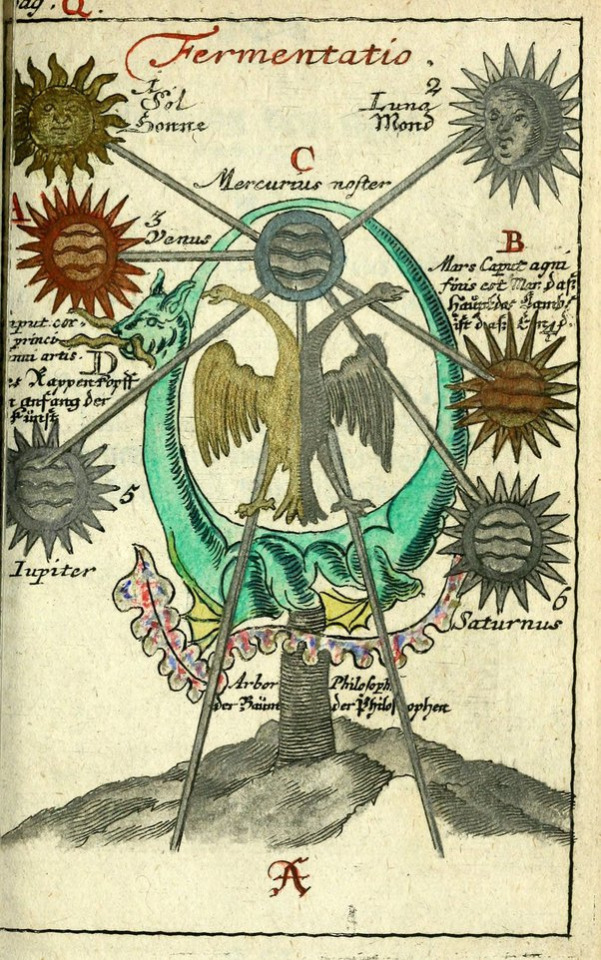
From Compendium Alchemyst
Paste: The whitened matter of the Stone. During the fermentation stage, another chemical wedding happens between the Stone’s purified soul and this white purified body, which is compared to making bread. The paste is bread dough.
Peace: The state when the opposing forces of the Opus (male and female, sulfur and mercury, fixed and volatile, body and soul, etc.) stop fighting with each other and are united in the chemical wedding. This is why a dove officiates the wedding. Signified by the “peacock’s tail” stage.
Peacock’s Tail: The stage between nigredo and albedo, when the stone is washed with mercurial water during ablution. As the blackness is washed away, it is replaced by the iridescent colors of the rainbow. Instead of white splitting into many colors as in a prism, the many colors coagulate into white. Eating the peacock’s flesh integrates the rainbow colors into the single white color, a state of purity and wholeness.
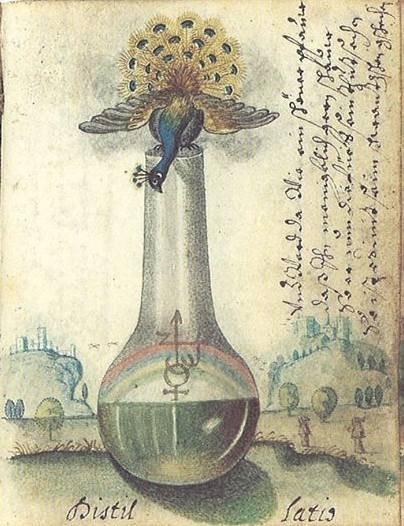
From the Ulrich Ruosch Manuscript
Pearl: A symbol of the ablution stage, because the drops of condensation that result from distillation look like pearls. Also a symbol of the White Stone.
Pelican: A symbol of the cibation and multiplication stage. The pelican bites her own chest to feed her hatchlings with her blood, like the Bird of Hermes feeding the baby Stone with the Red Tincture. (Pelicans don’t actually do this, but were believed to, and were considered symbols of Christ for their sacrifice of their own blood for their young.) Also a particular type of vessel.

From the Ulrich Ruosch Manuscript
Philosopher: An alchemist. This alone is an indication that alchemy isn’t about science, but about attaining spiritual wisdom. Hence why alchemical substances or symbols are described as “philosophical” – it’s not the literal, physical thing that matters, but the metaphorical or spiritual thing. Alchemy really happens in the mind, not in the laboratory. The alchemists sought to discover how the world works on both a physical level and a spiritual level, simultaneously.
Philosopher’s Stone: The ultimate goal of alchemy, substance that can supposedly perfect all imperfections (which I interpret to mean, it raises the vibration of anything it comes in contact with). It is the substance of divine love and creative power, a crystallization of the essence of life. It can supposedly turn lead into gold, heal all illnesses, and do various other miraculous things. It is created by reproducing God’s creation of the world in the microcosm of the alembic. It is supposed to be a perfect balance of all four elements, and is born from the divine union of the archetypal male and female forces of the universe. It is supposedly created by reproducing God’s creation of the world in the microcosm of the vessel, beginning with primordial first matter (prima materia) and shaping it into sulfur and mercury, which then “marry” and combine to produce the Stone. Honestly, seeking the Philosopher’s Stone is like going on a long Epic Quest for some magical unattainable object (like the Holy Grail or El Dorado), only to discover that It Was Inside Of You All Along, but the journey itself facilitated your character development to make you a better version of yourself. The point was always the journey; the Philosopher’s Stone is a natural result of having undertaken the Opus at all.
Philosophical Child: The newborn Philosopher’s Stone, the result of the Chemical Wedding. The final part of the Opus is compared to raising a child, who is fed and nourished by the alchemist. He grows up into a king and a magician who has power to “vanquish every subtle thing and penetrate every solid thing,” cure all disease, transmute all metals.
Philosophical Mercury: Prima materia or Mercurius. Not the same as “vulgar mercury” or quicksilver (Hg).
Philosophical Tree: Represents the Philosopher’s Stone, the process of the Opus, and also the “expansion of consciousness” that results from it. The process of making the Stone is compared to the cultivation of a tree, and the Stone multiplies itself like a tree bearing fruit. The tree grows from a seed, the “seed” of metals within prima materia, is nourished by rain, and it finally bears gold and silver fruit that represent the Sun and Moon (as well as “perfect” metal). This is all a metaphor for the spiritual growth of the soul towards its ultimate divine form. Sometimes the tree is instead a flower (like the red roses and white lilies, representing the Red and White Tinctures), or a magic herb. Sometimes there are two trees, a gold solar tree and a silver lunar tree. Sometimes it has seven branches to represent the seven planets, making it a symbol for prima materia. Sometimes it grows on an island in a sea of mercurial water, sometimes it grows on a mountain of prima materia, and sometimes it grows in a magical garden of wisdom.
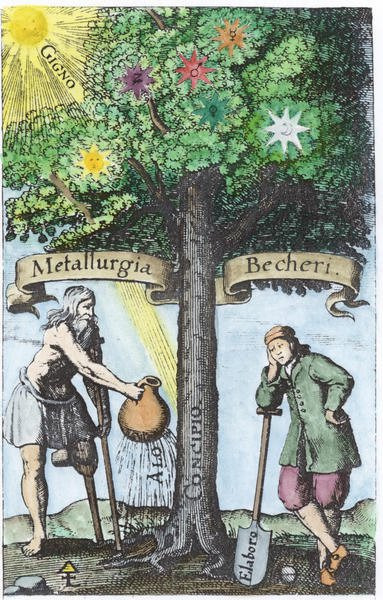
By Johann Joachim Becher
Phoenix: Resurrection, the Philosopher’s Stone in the red stage. Fire in its purest and most spiritual form. Represents rubedo and the multiplication stage, when the Stone/elixir replicates itself. It has been resurrected, and has the power to resurrect itself and others indefinitely.
Poppy: The rubedo, the red color of the Stone or Red Tincture in the final stage.
Pot: The vessel, in this case described as being made of clay and filled with dung to act as a container for the first Chemical Wedding and the nigredo, becoming “pregnant” with the seed of the Stone.
Prima materia: “First matter,” the primordial essence of all things. Alchemists believed that everything was made out of an original substance from which the world was made, and that if you could distill and refine matter (metal, for instance) all the way down into this original substance, you could reshape into whatever you wanted. i.e., reduce lead down to prima materia and then reform it as gold by putting a “seed” of gold into it. Hence “solve et coagula,” dissolve and reform. Symbolically, prima materia represents the soul in its original state. You have to be able to break down the person you think you are, until you are left with nothing but the true core of your being. In Jungian symbolism, it is also the subconscious mind, a dark and scary place that is also the source of inspiration and growth. Prima materia is compared to dirt or dung by alchemists, because it is supposed to something normal and mundane that is found everywhere, and dismissed as worthless by the uninitiated. There are so many symbols related to it, especially water, snakes, earth, seeds, blood, Saturn, chaos, and lead.
Prison: The vessel during the putrefaction stage. The alchemical lovers, Sol and Luna, are imprisoned in it and left to die while their souls rise to the top of the vessel.
Projection: Stage Ten. Using the Stone to transmute other metals, completing the cycle. The Stone raises the vibrations of everything it comes into contact with.
Proteus: The shapeshifting sea god in Greek mythology, a symbol of Mercurius in its volatile state, which takes on many confusing forms and has to be held down until it is tamed and takes its original shape. The sea that Proteus lives in is pirma materia.
Purple: Sometimes used to describe the Philosopher’s Stone and Tincture in its final rubedo state, instead of red. This is because Tyrian purple is very rare and hard to get, must be extracted from snails, and is only worn by royalty. It is the color of attainment, spirituality, and mastery.
Putrefaction: Stage Four. Subjecting the material to a moist heat and letting it turn black. It is now a dead thing with all of its characteristics stripped from it, prima materia. Vapor (the life-spark) leaves it. Represents spiritual death, melancholy, dejection, suffering. The Dark Night of the Soul. Death of the old self paves the way for a new mode of thinking, initiation.
Queen: The matter of the Stone during the albedo. The cold and moist female principle — mercury (Hg) in its impure state, silver in its pure state. She is the Moon, and must be “married” to her male counterpart, who represents sulfur and the Sun. She is also mercurial water in its role as the replenishing water of life or nourishing milk, the White Tincture. She represents the subconscious, perception and the imagination, “higher” spiritual and moral faculties, and the Divine Feminine.
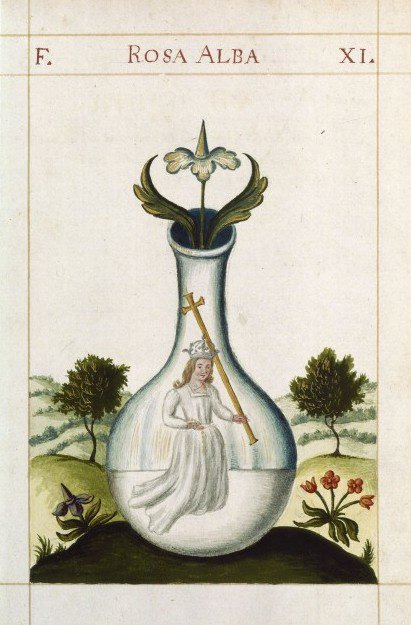
From Pretiosissimum Donum Dei
Quicksilver: Mercury (Hg). The agent of the feminine principle, the “unripe” form of silver. Cold, moist, receptive feminine “seed” of metal that unites with Sulphur to form the Philosopher’s Stone. It is made of Earth and Water. Confusingly, it can also be a symbol for Mercurius in its “slippery” and elusive form. In Paracelsian alchemy, it represents the spirit, the animating force of life. Sometimes also a synonym for prima materia, represented by the dragon or serpent. It has the power to dissolve or vaporize fixed matter. (Also called argent vive.)
Quintessence: (also called Azoth), the fifth element and the result of unifying the other four. It is what the Stone is made of, and in liquid form it is the Elixir of Life. It is purified prima materia, an inherently spiritual substance. Believed to be a panacea. (I interpret it as being able to raise the vibration of anything it comes in contact with.) Symbolized by a crowned maiden, or by Mercurius.
Rainbow: The peacock’s tail stage, which occurs during ablution, when mercurial water falls like rain onto the black dregs. The many colors of the rainbow integrate into white, representing the calmness and receptiveness of the soul.
Raven: Nigredo, when the impure matter of the Stone dissolves and putrefies in the bottom of the flask. It is the initial, death stage of the Opus.

From the Ulrich Ruosch Manuscript
Red: The rubedo, the final stage of alchemy in which the white matter of the Stone turns crimson as the spirit merges with the body. It crystallizes and becomes fixed. Self-actualization and resurrection, the attainment of spiritual enlightenment. Symbolized by blood, red roses, rubies, coral, gold, the Sun, the phoenix, and the King.
Red earth: A name for the base matter of the Philosopher’s Stone, which is dissolved into prima materia and then refined into the Red Stone and Red Elixir.
Red Elixir: The Philosopher’s Stone in liquid form, as a panacea. It can cure all diseases, transmute metals into gold and silver, raise the dead, make old people young again, give strength to living beings, etc. It is “fed” to the baby Stone during the cibation stage, so that the Stone will be multiplied by itself and produce more of itself. (Also called the Red Tincture)
Red Lion (or Dragon): Represents sulfur and the planet Mars. It’s Sol, the masculine principle, in its “impure” state at the start of the Opus: the wild, animalistic, instinctive part of the soul that needs to be “purified” by being defeated. It is “terrestrial man,” the King at his most mundane. It burns everything that it comes into contact with.

From Clavis Artis
Red powder: The Stone in powdered form. It’s cast over or mixed with metal to transmute it, and taken as a medicine.
Red Sea: Another symbol for prima materia and mercurial water, the source of life and death that both dissolves everything and revitalizes it. The crossing of the Red Sea in Exodus is a symbol for how its waters will destroy the uninitiated and show the way forward to the enlightened. It also can be “parted” into four elements.
Refine: Purifying a substance by repeatedly dissolving and coagulating it with water and fire, which slowly removes its defects. This is a metaphor for raising the “vibration” of the soul, from a lower, mundane state to a higher, spiritual state. The soul must endure many trials (fire and water) to reach this state of spiritual purity, until it is pure enough to permanently fuse with the spirit of God and become divine-in-human. Becoming “gold” is to be able to withstand the heat of any “fire” (gold has a very high melting point) and host the Sun within oneself.
Return: The “process of return” is a name for the Great Work, because it is a cyclical process of repeated “solve et coagula.” The matter of the Stone must return to prima materia, the four elements to quintessence, the soul to the perfected state that it was in at the creation of the world, the world itself from the dismal “Iron Age” to the ideal “Golden Age” of the distant past.
River: Another symbol of mercurial water. There are two rivers, one male and one female. The female one dissolves, and the male one coagulates. When the two rivers flow together into a single river, it represents the Chemical Wedding. When the rivers dry up, it represents the crystallization of the Stone in the dry, solar rubedo stage.
Rock: A synonym for the Philosopher’s Stone, for the mountain of prima materia, and also for the vessel in which the Stone is made.
Roots: The four elements are the “roots” of the philosophical tree, from which the Philosopher’s Stone grows.
Rose: The rubedo and the Philosopher’s Stone, the completion of the Opus. A blooming rose represents attaining wisdom and enlightenment. If a red rose is paired with a white lily (or a white rose), it represents the Red Tincture and the King/Sol.
Ruby: The Red Stone. The “celestial” ruby has the power to transmute all metals and make anyone enlightened.
Sable robe: Black garments (mourning clothes) are another symbol of the nigredo, the dark night of the soul.
Sal ammoniac: Ammonium chloride. It’s a symbol of the White Tincture, the matter of the Stone during sublimation, after it has been dissolved. It’s represented by the eagle. It’s also an ingredient in aqua regia, because it produces hydrochloric acid when dissolved.
Salamander: Sulfur, the hot and dry male principle and the masculine “seed” of metals. Although salamanders are amphibious creatures, they were believed to be able to withstand flames, hence why they’re associated with fire. Paracelsus named them as fire elementals, implying that (in this context) salamanders are a type of spirit. Also represents the Philosopher’s Stone and Red Tincture, similarly to the phoenix. The salamander’s blood is the panacea.

From Atalanta Fugiens
Salt: Represents the body and the state of fixation in Paracelsian alchemy, with mercury being the spirit and sulfur the mediating soul. Traditionally, though, it’s a synonym for ashes and white foliated earth, another symbol of matter of the Stone in the white stage.
Sand: Another version of the bath, but the Vessel is placed in heated sand instead of water. Red sand is also a symbol of the raw matter of the Stone.
Sapientia: Divine knowledge and wisdom, which is what the alchemist ultimately hopes to obtain. It is the divine feminine principle, represented by the Queen. Wisdom is personified as a beautiful woman who is an emanation of God. She is the active ingredient in the panacea.
Saturn: Represents the metal lead, and the color black. Also a name for prima materia and for the matter of the stone during the putrefaction stage. In general, Saturn represents discipline, death, and melancholy, so her rules over the harsh nigredo stage. Sometimes he is portrayed as a Grim Reaper or Father Time figure, who destroys all old things to make way for new things.
Sea: Mercurial water, prima materia, the source of all creation. Most creation stories begin with primordial waters of some kind, so of course, the ocean represents this primeval soup of prima materia that contains the potential for all things. (Modern science tells us that life on earth literally did begin in the ocean.) Drowning the King in the sea represents dissolution.
Seed: The spark of life. All metals were thought to have a “seed” within them that could produce the Philosopher’s Stone, when the metal was dissolved into prima materia and the seed extracted from it. The hot and dry male seed is sulfur, and the cold and moist female seed is quicksilver. The seed could theoretically “grow” into gold, under the right conditions and with aid from the Philosopher’s Stone.
Separation: Stage Three. The mixture of ash and “water” separates into its base materials (the four elements, mercury and sulfur, etc.). This represents sorting out the aspects of your mind. It feels like you’re now split in two, Ego and Shadow, warring with yourself. There’s a danger of self-loathing.
Serpent: Prima materia. Mercurius in the form of primordial chaos, dark and destructive. The universal solvent is the serpent’s venom, which can reduce any metal to prima materia. Chthonic or cosmic serpents so often represent primordial creation in mythology — Apophis and Nehebkau in Egypt, Tiamat in Mesopotamia, Shesha in Hinduism, etc. Mercurius also manifests as two serpents that represent the male and female seeds of metals – the female one is winged, and therefore the volatile spirit hidden in the matter of the Stone, while the male one is fixed and does not have wings. They fight each other until Hermes places his wand between them, and they coil around it to form the caduceus. After these two serpents die in the nigredo stage, the primordial serpent becomes the river serpent who cleanses and resurrects them with the water of life. Finally, it becomes the representation of the Philosopher’s Stone.

From The Crowning of Nature
Ship: The vessel, during nigredo and the dissolution that follows. If dissolution is symbolized by a flood, then the alchemical vessel is the ship. Same symbolism as a coffin.
Silver: The symbol of the albedo stage, the Whtie Stone, and the White Elixir, as well as the Moon and the Queen. A pure, condensed form of the lunar force and the Divine Feminine.
Snow: The matter of the Stone during the albedo, the same as white foliated earth. The dust that collects on the side of the vessel during sublimation. Throwing snow in Saturn’s face is a symbol of turning the blackened matter of the stone white, as the Work progresses into the albedo stage.
Seven: Creative power, transcendence. Three creative principles (sulfur, mercury, salt) + four elements, nature creating nature. Transitioning to “nonhuman” consciousness.
Soul: The vapor that results from dissolution, because it is volatile and therefore the spiritual part of a living being. The divine or “higher self.” When the matter of the Stone is dissolved into prima materia, the soul is released and floats upward. It unites with the spirit in the Chemical Wedding, during the albedo stage.
Spirit: The spark of life, the spiritual essence of a person or substance, mediating between the dead body and the soul. Symbolized by flying birds in the flask, and represented by mercury (quicksilver) in Paracelsan alchemy
Square and Circle: A symbol of the Philosopher’s Stone. The square represents the four elements, and “squaring the circle” means uniting those four elements into one Quintessence. The four-sided square is the material world, and the eternal circle is the spiritual world. It’s also a symbol of sacred geometry and harmony, the proportionality of the microcosm to the macrocosm.
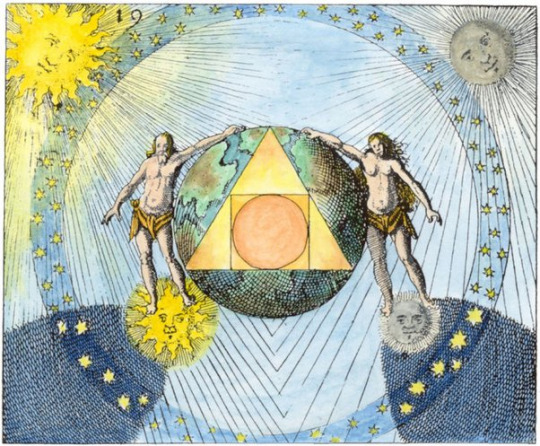
From Philosophia Reformata by Johann Daniel Mylius
Stain: The impurities in the matter of the Stone that have to be filtered out through the continued process of refinement, solve et coagula. Ablution is the stage of washing the stains away, following death and dissolution. Washing away the stains is a metaphor for acknowledging one’s own shortcomings, and working through one’s faults to become a better person,
Star: Another symbol of Mercurius. A six-pointed star represents Mercurius’ ability to unite opposites (the upward- and downward-facing triangles; as above, so below), If it has a sun and moon in the middle, it represents the Chemical Wedding. A six-pointed star also contains the triangular symbols for all four elements. Stars also symbolize the Stone as the perfected human being. The “milk” that the baby Stone is nourished with comes from the stars. (Also a symbol of antimony, because antimony crystallizes in a star pattern when reduced with iron.)
Sulfur: An “impure” (physical) agent of the masculine principle, the “unripe” form of gold, Hot, dry, active masculine “seed” of metals that has to combine with feminine mercury (quicksilver) to form the Philosopher’s Stone. It is made of Air and Fire. It is not literal sulfur, but the mundane mind or consciousness. It is combustive and violent, but it is able to fix the volatile. It is symbolized by a red lion or the Devil. In Paracelsian alchemy, it represents the soul, and is the force of structure, stability, substance, and growth.
Sun: Represents the metal and color gold, and “philosophical gold.” He is the Divine Masculine, represented by gold, or sulfur (in an impure state). Sol is married to Luna, the Queen. His properties are hot, dry, and active to her cold, moist, and receptive. He represents individualization, completion and perfection to the point of centrality, stability, equilibrium, and order. The state of being divine. Also represents the illumination of consciousness, the Red Tincture, and Red Stone during the rubedo, at the completion of the Opus. It represents the state of being the Philosopher’s Stone, the “perfect incarnation.” Its rays have the power to transmute metal and give life. Associated with coagula, congelation, the giving of form and physicality to the subtle or spiritual.
Sun and Shadow: A strange symbol of the projection, the final stage of the Opus. The Sun shines, and casts a shadow, which is a symbol of the Philosopher’s Stone being cast over other metals to turn them to gold. The Shadow is part of what makes the Sun what it is, because wherever there is light, there is shadow. Sometimes the Shadow itself is the Philospher’s Stone, because it is a microcosm of the Sun, which is the macrocosm. It is like a reflection or impression of the Sun. Sometimes the Moon is the Shadow, because it reflects the Sun’s light, so the lunar eclipse is the Chemical Wedding – the integration of conscious and subconscious. During the lunar eclipse, the moon turns red, like the Philosopher’s Stone. The solar eclipse symbolizes the beginning of the Great Work, while the lunar eclipse symbolizes the end, though both could be interpreted as symbols of the Dark Night of the Soul and the integration of the Shadow self.
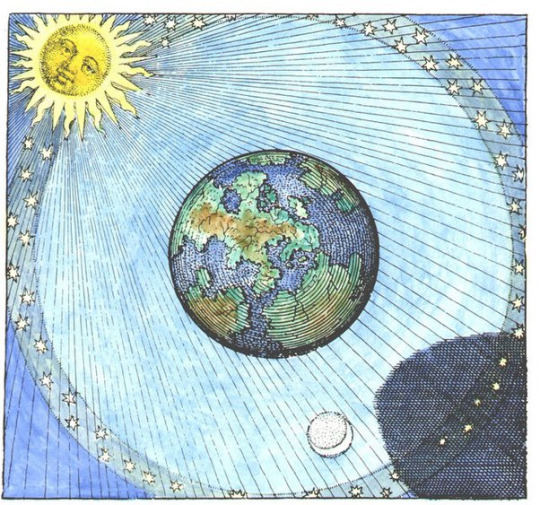
From Atalanta Fugiens
Swan: The albedo, the White Tincture and the White Stone. It swims in the mercurial water, It is feminine and lunar, and able to transmute metals into silver, and represents spiritual purity.
Sweat: The dew or condensation on the side of the vessel during the distillation phase, and is used to wash the dead body of the King during ablution. It’s also the King’s own sweat as he dies, therefore Mercurius as the waters of both life and death.
Sword: Represents “philosophical fire,” the destructive force of Mars and the Red Lion/Dragon. It kills the King (the matter of the Stone), which results in the nigredo stage. (An axe, a knife, Saturn’s scythe, or animal teeth and claws all have the same symbolism)
Tartarus: The dregs or sediment of wine. The Underworld, that which is left behind by the once-living world.
Tears: Mercurial water in the form of the water of life that washes the dead matter of the Stone and cleanses it of impurities. Same symbolism as sweat and dew/rain, the condensation on the sides of the alembic during distillation. In this context, the tears come from grief over the dead King, bird, or lovers.
Temple: Another name for the Vessel, containing all the secrets of alchemy and generation.
Theatre: Alchemical treatises call themselves “theatres,” because they provide a view of the Opus. The Opus itself is compared to a theatrical performance taking place on a stage, and watched by an audience, with all the apparatus being the set and the individual stages being acts and scenes. The theatre is therefore another symbol of the Vessel or alembic.
Tincture: A liquid that is able to tint or color other things. The Stone in liquid form is called a “tincture” because it is able to “color” metals when poured on them to turn them into gold and silver.
Toad: The matter of the Stone during the putrefaction stage, which is black, ugly, and swollen. Also a symbol of prima materia – hardened, earthy primordial matter that’s poisonous but that can be made into the Stone. Means the same thing as the snake or dragon, the crow or raven, and the Green Lion. If paired with a volatile eagle, it represents sublimation.
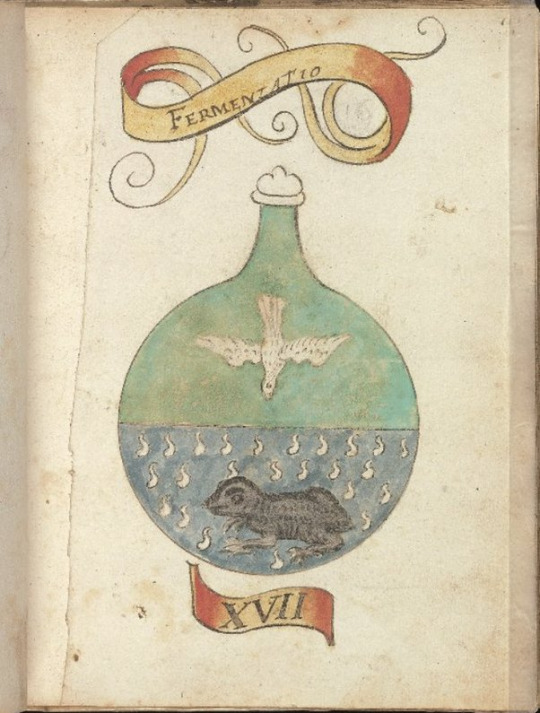
From The Crowning of Nature
Torture: Calcination, reducing a metal to ashes and prima materia during the nigredo stage. This requires being burned in purifying fire. Beheading the king, chopping down a tree, or the bird eating its wings all represent the same thing. This is a symbol of the psychological torment that one must go through during the nigredo, to become self-aware and spiritually pure.
Trees: Prima materia — the force of manifestation, wisdom, the Divine, alternately a creative and destructive force. Yggdrasil provides wisdom to Odin at the cost of his suffering. The Tree of Paradise provides divine knowledge at the cost of sin, etc. Also, “As above, so below,” since the tree’s roots spread beneath it and the branches spread above it. It can also represent the dual nature of mankind, being both divine and mortal, connected to the Astral world and the terrestrial world.
Twins: Sometimes the Red King (sulfur) and White Queen (quicksilver) are interpreted as twins, the two principal forces of nature that are born from prima materia and united with each other. They seem to be opposites, but they’re of the same stock. Sometimes they’re conjoined into a two-headed hermaphrodite.
Unicorn: The masculine aspect of Mercurius, which can penetrate with its horn. Represents the spirit, while the deer represents the soul. The deer and unicorn must both be captured and tamed by the alchemist, so that they will mate with each other, representing the second Chemical Wedding between soul and spirit (during the albedo stage). The unicorn can only be tamed by the Virgin, who represents the feminine aspect of Mercurius.
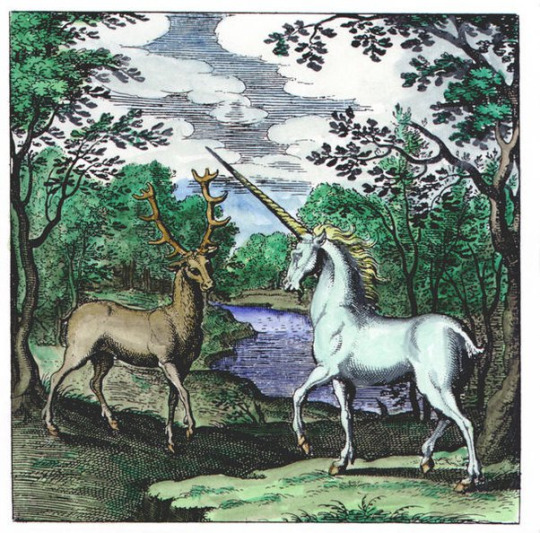
From The Lambspring
Urine: Mercurial water during the putrefaction stage, the universal solvent.
Venom: Alkahest — mercurial water at the beginning of the Opus, as a universal solvent that burns and destroys everything it comes into contact with. It “kills” the matter of the Stone during the nigredo stage, reducing it to prima materia. It is symbolized by venomous animals (or animals thought to be venomous) like snakes and toads. Also symbolized by the blood of the dragon or Green Lion. The venom is then transmuted into the water of life. Spiritually, this is a symbol of the psychological turmoil that you go through when you first become aware of your Shadow or lower self, which becomes a blessing once you overcome it. Self-awareness is painful at first, but is a means towards divine knowledge and purity. (also called vinegar)
Venus: Represents the metal copper, and the color green. She is the impure version of the Divine Feminine, just as Mars is the impure version of the Divine Masculine. She first appears as a “whore,” representing the impure matter of the Stone that quicksilver (a purer version of the Divine Feminine) must be extracted from. Mars and Venus are the alchemical couple before they become Sol and Luna. Sometimes she also presides over the Chemical Wedding and its results, wearing green. The matter of the Stone turns green just after the black nigredo and just before the rainbow Peacock’s Tail.
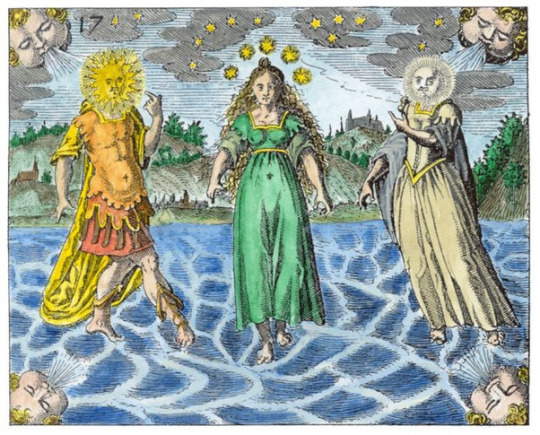
From Philosophia Reformata by Johann Daniel Mylius
Vessel: The flask or alembic in which the Philosopher’s Stone is made. Spiritually, it represents you – your body and consciousness. Your microcosm, in which the Great Work takes place.
Viper: The impure matter of the Stone at the beginning of the Opus, and also the mercurial spirit that is released from it when it is dissolved. It is poisonous and violent, because it has not been refined yet.
Virgin: The feminine aspect of Mercurius. Prima materia, which was “impregnated” by God to create the world, and generates all things. Also a symbol of argent vive (quicksilver), the cold and moist feminine principle. Represented by Diana (Artemis), the virgin huntress, who is also a symbol of the Moon (i.e. the Queen). Sapientia (wisdom) is also a form of the Virgin, this time representing the Philosopher’s Stone. In this aspect, she is a cosmic world-soul (similar to Hecate in the Chaldean Oracles). “Virgin’s milk” is the purifying and transforming form of mercurial water, and the White Tincture.
Vitriol: Sulfate, or sulfuric acid. “Green vitriol” (iron sulfate) is the impure matter of the Stone (i.e. the Green Lion), while “red vitriol” is purified sulfur.
Vulcan: Hephaestus, the smith of the gods, who is the archetypal alchemist in Paracelsian alchemy. This is probably because he works with metal and makes things out of gold. He also represents the “secret fire,” the purifying divine fire.
Vulture: The Bird of Hermes and a symbol for the entire alchemical process, because it is black, white, and red.
Water: The element, the essence of peace. Prima materia, primordial creation, chaos, darkness/the Abyss, philosophical mercury. It is cold and moist, and contains infinite possibility and creative potential, as well as volatile destruction. Also represents the Divine Feminine (i.e. the womb of creation). Symbolized by the Moon and quicksilver (mercury). In its destructive form, mercurial water is the universal solvent that reduces everything to prima materia, and then it transmutes into the purifying and revitalizing water of life.
Watering [plants]: Watering the philosophical tree symbolizes distillation and ablution, imbuing the body of the Stone with its spiritual essence.
Well: The vessel during dissolution, the container for the mercurial water. Another symbol for the baptismal bath or fountain.
White: The albedo, the second stage of alchemy, when the vapor from the dying matter of the Stone rises to the top of the alembic, and the dead body of the Stone is washed in the mercurial waters. The human soul is washed clean of its sins and sorrows at this stage, and is capable of receiving divine love and inspiration. It represents purity and the giving of new life. Symbolized by milk, white roses, lilies, silver, snow, the water of life, the Moon, the swan, the dove, and the Queen.
White Elixir: The White Stone in liquid form, an elixir with the power to transmute base metal into silver, obtained at the albedo stage. It can cleanse anything of its stains and purify matter into a near-perfect state. It is the milk that is “fed” to the baby Philosopher’s Stone during cibation. (Also called the White Tincture).
White Foliated Earth: The matter of the Stone in the albedo stage, which has decomposed, been purified, and become white fertile soil. The seed of gold is “planted” in it, so that the Stone will be able to transmute base metal into gold. The white earth is watered when the soul reunites with the body. Symbolized by ash, dust, salt, or snow, and Luna/the Queen.
White Stone: The matter of the Stone as it is during the albedo stage, able to transmute base metal into silver. It is the mundane body having become pure and spiritual through repeated refinement (distillation/sublimation). Symbolized by Luna, the White Queen.
Wind: The vapor at the top of the flask, Mercurius during the sublimation stage. It is the soul that contains the life-spark, “the wind shall carry it in its belly.” The Stone at its most subtle. Eventually, it condenses and turns to water, then falls back to Earth again. (Also called zephyr)
Wolf: Antimony. It devours the body of the King when he dies during the nigredo stage, symbolizing his destruction by the mercurial waters. Similar symbol to the Green Lion.
Womb: The vessel, in which the Stone is conceived. Also a symbol for the bath or fountain that cleanses the matter of the Stone, and a symbol for the white foliated earth in which the “seed” of metals grows. The earth is “impregnated” by the spiritualized soul, which condenses and falls to the earth. When this happens, the Stone is born.
Worm: Another symbol for the mercurial water and secret fire, that destroys and then revitalizes matter. Interchangeable with the serpent or dragon. It decomposes the dead body of the Stone during the putrefaction, eating away all corruption.
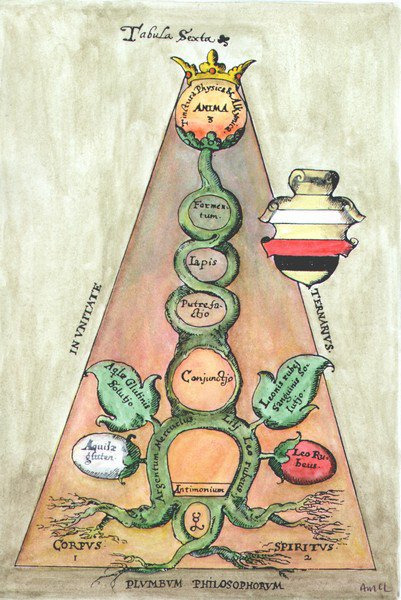
From The Marrow of Alchemy by George Ripley
#alchemy#alchemical symbols#alchemical symbolism#hermeticism#hermetic symbolism#alchemical#mercurius#occult#occultism#occult symbolism#dictionary#symbolism#symbol dictionary#philosopher's stone#long post
169 notes
·
View notes
Text
MYTHOLOGICAL In populations across North Eurasia, from Indo-European groups in the far west to the Chukchi in the far east, as well as in the Americas, two styles of myth can be found with striking consistency; an "Earth Diver" creation myth, and a myth in which a monstrous dog guards the underworld, where getting past it acts a test for deceased souls.
The "Earth Diver" myth generally follows a plot where some animal/being is sent to dive to the bottom of the primordial ocean to collect a small amount of sand or mud, from which a supreme creator deity constructs the first dry land. This story, with minor variations, is found in the mythos of Northeast Asian, Siberian, and Eastern European populations such as the Samoyedic peoples, Turkic peoples, the Buryats, the Ainu, Chukchi, Yukaghir, Slavs, Lithuanians¹²³⁴, etc, as well as Native American groups; Blackfoot, Arapaho, Athabaskans, Cayuga, Nipmuc, Ojibway, Potawatomi, Mohawk⁵, etc.
The Afterlife-Dog-Guardian myth is found throughout Indo-European cultures; you are most likely familiar with Cerberus from Greek mythology. It's also found among the Chukchi and Tungusic peoples. There's remains of dogs that appear to have been ritualistically slaughtered at Mesolithic sites in Siberia, which may be related to this myth. In North America, the mythos of Siouan, Algonquian, and Iroquoian peoples also generally feature a fierce dog guarding the path to the afterlife; however, in their myths, the path is the Milky Way in the sky, rather than the underworld⁶.
Now, if this consistent continuum of distribution wasn't convincing enough, there's now also archaeogenetic evidence that further implies these two myths have a common origin (which would make them among the oldest reconstructable stories we know of.) Genetic analysis infers the existence of a Paleolithic/Mesolithic grouping of people in North Eurasia aptly known as the Ancient North Eurasians. The thread that defines the ANE is close relation to the 24,000 year old Mal'ta Boy remains from the Lake Baikal region⁷. The Ancient North Eurasians were an extremely prolific and important population; to the East, they've contributed ancestry to modern Siberian populations (and to a lesser extent, East Asians), and a large amount to Native Americans; 40-50% of Native American DNA is ANE in origin⁷. To the west, they mixed with various West Eurasian hunter-gatherers to form Mesolithic lineages such as the Caucasus Hunter Gatherers, Eastern European Hunter Gatherers, West Siberian Hunter Gatherers, and Scandinavian Hunter Gatherers. Proto-Indo-Europeans descended from a mixture of Eastern European Hunter Gatherers (70-75% ANE, 30-25% Western European Hunter Gatherer) and Caucasus Hunter Gatherers⁸ (45-62% Dzudzuana/Archaic Caucasus HG, 55-38% ANE⁹). This shared ancestry lends credence to the idea that this pattern of myths could have a common origin in North Asia predating the migration of people to the Americas.
Furthermore, very recent research (a few months ago) suggests that the domestication of the dog occurred in Siberia around 23,000 years ago, where, from there, they spread throughout Eurasia and into the Americas; the people responsible for the domestication are identified in the initial study as "Ancient North Siberians"¹⁰ , though they were described as being associated with the Mal'ta remains and are thus synonymous with Ancient North Eurasians. Not necessarily strong evidence in its own right that the Afterlife Dog myth comes from them, but I definitely think it's worth mentioning. There's also rituals consistently associating dogs with healing and protection through their perceived ability to absorb illness found in ANE-descended populations such as the Hittites, ancient Greeks, ancient Italics, Turkic peoples, Babylonians (Mesopotamia is adjacent to where Neolithic Iranians lived, who also had a large amount of ANE ancestry), and possibly the ancient Botai culture⁶.
(And just as a fun fact, blonde hair among West Eurasians is believed to have originated with the ANE; the earliest person known to have been genetically predisposed to blonde hair was the ~17,000 year old ANE-descended Afontova Gora 3 girl from central Siberia.)
CULTURAL
Broadly similar religious practices that can be described as shamanism are mostly distributed among East Asians (especially Siberians) and, quite famously, Native Americans¹². Uralic peoples, who ultimately originate from east Siberia¹³, brought it to Europe. The fact that shamanism is found in many different East Asian populations, including ones with little ANE ancestry in southern China, east India, and Southeast Asia, but is/was essentially absent in West Eurasia (as far as we know), suggests that the practice has an ancient East Asian origin, and that Native Americans picked it up from their East Asian ancestral component (40-50% of their DNA from ANE, 60-50% from Ancient East Asian)
Of course, shamanistic practices are also present in cultures from Sub Saharan Africa, and among Australian Aboriginals, so as a whole the concept obviously emerged multiple times, but the particularly strong concentration of it among the deeply related peoples of East Asia, Siberia, and Native America might indicate that theirs does have some sort of common heritage.
LINGUISTIC
In 2010, linguist Edward Vadja published The Dene–Yeniseian Connection, the culmination of years of his research, wherein he proposes that the Yeniseian language family of Central Siberia, and the Na-Dene language family of North America (which includes such languages as Navajo and Apache), are related¹⁴. This paper was actually well received by a number of respected linguists, the first theory connecting Old World and New World languages to receive this treatment. In a 2012 presentation, Vadja bolstered his theory with further comparative linguistic evidence, as well as non-linguistic evidence; the most compelling example of the latter being the fact that haplogroup Q1, which is very common throughout indigenous populations of the Americas , is found at a rate of nearly 90% among the Yeniseian Ket people (and at a rate of 65% in their neighbors, the Samoyedic-speaking Selkup, who have long intermixed with Yeniseians.) The Navajo have this haplogroup at a rate of 92%. The Ket people also have among the highest amount of ANE-derived ancestry out of any modern day population, similar to Native Americans¹⁵.
A possible scenario explaining the proliferation of the family: when the ancestors of most other Native Americans migrated over into the New World, a subset of them remained behind in Beringia for several millennia. Eventually, as Beringia began to flood ~10,000 years ago, the group split, with some going back into Asia to become the Yeniseians while others finally moved into America to become the Na-Dene. While this is certainly much older than the dating for most other established language families, it is not implausible; Proto-Afro-Asiatic, for example, is routinely dated to well over 10,000 years ago. However, Vadja himself postulated that Na-Dene might have arrived in America through a distinct migration which postdated the initial peopling of the continents.¹⁶
Today, Dene-Yeniseian is still not a universally accepted, firmly established language family, but its not widely rejected either; it remains an open, favorable possibility while further research is done. For the sake of fairness, here is an example of a critical review which doubts the theory as Vadja proposed it: http://www2.hawaii.edu/~lylecamp/Campbell%20Yeniseian%20NaDene%20review%2011-2-10.pdf
SOURCES
Sacred narrative, readings in the theory of myth, Alan Dundes, page 168-70
Earth-Diver Myth (А812) in northern Eurasia and North America: twenty years later, Vladimir Napolskikh
A Dictionary of Asian Mythology, David Adams Leeming, page 55
The Motifs of creating the world in the Lithuanian narrative folklore, Nijolė Laurinkienė
http://www.native-languages.org/earthdiver.html
Tracing the Indo-Europeans: New evidence from archaeology and historical linguistics, David W. Anthony & Dorcas R. Brown, page 104-105
Upper Palaeolithic Siberian Genome Reveals Dual Ancestry of Native Americans, Pontus Skoglund & Maanasa Raghavan
Archaeology, Genetics, and Language in the Steppes: A Comment on Bomhard, David Anthony
Paleolithic DNA from the Caucasus reveals core of West Eurasian ancestry, Josif Lazaridis, Anna Belfer-Cohen, Swapan Mallick, Nick Patterson, Olivia Cheronet,Nadin Rohland Guy Bar-Oz, Ofer Bar-Yosef, Nino Jakeli, Eliso Kvavadze, David Lordkipanidze, Zinovi Matzkevich, Tengiz Meshveliani, Brendan J. Culleton, Douglas J. Kennett, Ron Pinhasi, David Reich
Dog domestication and the dual dispersal of people and dogs into the Americas, Angela R. Perri , Tatiana R. Feuerborn, Laurent A. F. Frantz, Greger Larson , Ripan S. Malhi, David J. Meltzer, Kelsey E. Witt
The genomic history of southeastern Europe, David Reich + many many more names
https://upload.wikimedia.org/wikipedia/commons/0/0c/Map_of_Shamanism_across_the_world.svg
The Arrival of Siberian Ancestry Connecting the Eastern Baltic to Uralic Speakers Further East, Lehti Saag
Reviewed Work: The Dene–Yeniseian Connection by James Kari and Ben A. Potter
Genomic study of the Ket: a Paleo-Eskimo-related ethnic group with significant ancient North Eurasian ancestry, Pavel Flegontov
DENE-YENISEIAN LANGUAGE FAMILY: EVIDENCE FOR A BACK-MIGRATION TO THE OLD WORLD? German Dziebel
26 notes
·
View notes
Note
hi lovelies i am looking for a fic where hermione had dracos kid and i am not sure if he knew about it because i remember narcissa and lucius didn’t know but i remeber the kid was a boy and he always carried around a dictionary to look up words he heard in conversations
This?
Better Dig Two by Kittenshift17 - M, WIP - Hermione Granger never expected she’d wind up pregnant with a lovechild fathered by a mystery man she’d been with to get back at Ron for cheating. Her drunken revenge leads to the birth of her son. 5 years later she is confronted by Draco Malfoy with a photo she thinks is of her son. This get complicated when he tells her it’s not. EWE. HG/DM. HG/RW.
- Lisa
8 notes
·
View notes
Text
What is Biopolitics? – Dictionary of Arguments
Power analyses that make use of the concept of #biopolitics focus on the concept of life - and not on the citizen, the subject, the subserviant - and thus focus on the growing current "politicization of life". Brocker I 827 Agamben now combines Foucault's shifts to biopolitics (1) with Hannah #Arendt's shifts to the concept of life. (2) AgambenVsFoucault: he has failed to shift his field of activity to the policies of the great totalitarian states of the 20th century. (3) AgambenVsArendt: their analysis of totalitarian states lacks the aspect of biopolitics. Solution/Agamben: Agamben brings the two strands together in the terms "naked" and "holy" life. See Holiness/Agamben, Terminology/Agamben, Life/Agamben, Humans/Agamben. 1. Cf. Michel Foucault, Sexualität und Wahrheit, Bd. 1: Der Wille zum Wissen, Frankfurt/M. 1977. 2. Hannah Arendt, Vita Activa oder vom tätigen Leben, München 1960. 3. Giorgio Agamben, Homo sacer. Il potere sovrano e la nuda vita, Torino 1995. Dt.: Giorgio Agamben, Homo sacer – Die souveräne Macht und das nackte Leben, Frankfurt/M. 2002, p. 127. Maria Muhle, „Giorgio Agamben, Homo sacer – Die souveräne Macht und das nackte Leben“, in: Manfred Brocker (Hg.) Geschichte des politischen Denkens. Das 20. Jahrhundert. Frankfurt/M. 2018
2 notes
·
View notes
Text
High Gavellian Dictionary #18

2 notes
·
View notes
Text
Harry Potter #3
Hey Guys, I'm SaffireWhite and I'm a fangirl
I'm gonna start off with one of the most popular fandoms, Harry Potter. Yes, Harry Potter cliché right.
Okay so I am going to list fanfictions under my 6 favourite ships for this fandom, I was going to do 5 but I couldn't decide. Now, these fanfictions include marauder era fanfics, The next gen, time travel fics, and the main Harry Potter era fics. They will include a summary and a link. These ships are not in order of favouritism, but they are my favourite ships for Harry Potter. Each ship will have 3 of my favourite fanfictions for these ships, there is however an exception section, where all of the other fanfics that I love are there, no matter the ship. Enjoy!
Draco/Harry
Myrmidon - MidnightCharm18188
Harry suddenly changes into a magical creature. The blood has laid dormant for generations but due to the Voldemort issue, the gene became active. He now has to find a mate or go insane. What will he do when he discovers his mate is Draco Malfoy?
House Proud - Astolat
His house liked Draco Malfoy more than him.
A Choice Of Wings - Lomonaaeren
A Choice of Wings is Harry's business for matching Veela who haven't automatically found mates with people who might make them good partners. And Draco Malfoy is his most difficult client.
Harry/Hermione
H J Potter - S.M wane
Who would expect that sharing a simple kiss with his best friend was all it needed to begin a journey far beyond his greatest imagination? Soul-bond fic
Harmony - insynclikeharmony
Harry and Hermione playing Scrabble one night in the tent. Seems simple enough but it turns into a trip down memory lane... and a look to the future? *Post-Ron exit*
A powerful Patronus - insynclikeharmony
Yet another short HxHr drabble. Takes place in POA!
Draco/Hermione
Animal Instincts - gnrkrystle
Five years after Hogwarts, Hermione and Draco are thrown together after a certain 'Malfoy trait' kicks in and Draco needs Hermione's help.
Isolation - Bex-chan
He can't leave the room. Her room. And it's all the Order's fault. Confined to a small space with only the Mudblood for company, something's going to give. Maybe his sanity. Maybe not. "There," she spat. "Now your Blood's filthy too!" DM/HG. PostHBP.
Proximate - In Dreams
Following a tumultuous break-up with Ron, Hermione finds herself intoxicated and relatively prone to poor decision making after she runs into Draco Malfoy in a club, having been years since she has seen him. Upon seeking to escape the following morning, she realizes he is her new neighbour and is quite insatiable. Winner of best Healer!Hermione in the Granger Enchanted Awards 2018.
Remus Lupin/Sirius Black
One night stand - Kawaiitenshi27
Werewolves mate for life. What are the consequences of a night of drinking? Slash. SBRL. Complete.
A mate - Awe
RS slash. Remus is confronted by a big problem, his wolf side keens for a mate and the only way to keep himself sane is to find one. Yet the only person Remus could even contemplate as a life partner could never be his, could he? COMPLETE!
Of mates and chocolate - sevensinsinthenight
Slash! Remus wants his mate, all the while having an extreme craving for chocolate. He might just end up getting them both at once.
Salazar/Harry
Gelosaþ in Écnesse - Batsutousai
Caught in the backlash of Voldemort's Killing Curse, Harry is thrown through time to a world so very different from his own.
Snakes and lions - FireHedgeHog
He ended in the future by accident, with no way back. he found love. Mpreg
In Éirinn - Batsutousai
While destroying the Horcruxes, the trio finds the most unlikely of allies in the most unlikely of places.
Lily Luna Potter/Teddy Lupin
Mates - Hetaliahufflepuff33
Teddy found out that Lily is his Werewolf mate, they have a lot ahead of them.
Daddy, I'm in love - jojo99
"Daddy, I'm In Love," said eighteen-year-old Lily Potter. Harry knew that this would be an interesting conversation as Lily was being evasive about who she was in love with.
Like it like that - jojo99
Lily is in a disastrous relationship and arrives at Teddy's late one night, angry. Should Teddy reveal how he feels about her boyfriend and his own feelings? Rating for one small section only.
Exceptions(no summaries)
Dog days - Sirius/reader
When Luna meet Rolf - Luna/Rolf
Pranking Queen - James Potter I/OC
A New Addition - Charlie/Harry
Potterella - Draco/Harry
Drarry fanfic: Well That Escalated Quickly - Draco/Harry
We learned the sea - Draco/Hermione
Mrs Potter - Marauder era Fanfictions
Alexaviera Raven Productions - all Fics
Draco and Hermione - Fic
It was so hard to figure out my top 3 fanfictions for all of them, lots of rereading. If you think that I have chosen wrong for any reason, if you think there are better ones or ones I should read whether the ships are on my list or not, just leave a note, love to hear from you guys!
Here are some websites that I suggest you look at:
The ultimate guide to fanfiction and fanfiction sites
21 harry potter fanfiction to read before you die
Fangirl dictionary
Fangirl dictionary
What should I do next?
#fandoms#fangirls#fangirl#dramione#drarry#harmony#harmione#wolfstar#im a fangirl#and im a fangirl#slytherin#draco malfoy#hermione granger#hermione#harry potter#lily luna potter#teddy lupin#sirius black#remus lupin
5 notes
·
View notes
Text
*** منشور آخر للحفظ ***
دعوة خير خاوتي 😔
مجموعة من المواقع و الدروس لي يفيدوك
1- من أجمل المواقع لي ممكن تساعدك في تحسين كتابتك بالإنجليزية قواعديا وتصحيح الأخطاء اللغوية .. تقدر أيضا تضيفو كأداة ف "جوجل كروم" ...
https://www.grammarly.com/
2- أيضا باش تحسن سرعة كتابتك بالإنجليزية استخدم هذا الموقع لي يخليك تتعلم الكتابة ...
http://play.typeracer.com/
3- لمحبي الكتب الإلكترونية .. هذا "محرك بحث" فيه أكثر من 300 مليون كتاب الكتروني مجاني في جميع المجالات ...
https://www.pdfdrive.net/
4- موقع تلقى فيه 8 آلاف قاموس ترجمة مباشرة من و إلى كل لغات العالم ...
https://m.lexicool.com/dictionary-search.asp
5- أكثر من 1100 كتاب في أغلب المجالات باللغة العربية والإنجليزية ...
https://drive.google.com/drive/folders/0ByWO0aO1eI_MN1BEd3VNRUZENkU
6- "ويكي هاو"... موقع تعليمي إرشادي وموسوعة ضخمة عن كيفية عمل أي شيئ تتخايلو .. 100 ألف مقال في مختلف مجالات الحياة .. والفيديو مايفوتش 10 دقائق .. متوفر ب 60 لغة ولهجة منها العربية .. وعندهم تطبيق للهاتف ...
https://ar.m.wikihow.com/%D8%A7%D9%84%D8%B5%D9%81%D8%AD%D8%A9-%D8%A7%D9%84%D8%B1%D8%A6%D9%8A%D8%B3%D9%8A%D8%A9
7- موقع مميز لتعلم اللغات .. تقدر تتعلم منو مثلا الإنجليزية باللغة العربية .. الموقع يعطيك تحدي تحفظ 100 كلمة كل يوم .. ويعاود الكلمات لي تغلط فيهم حتى تنطقهم صحاح .. ويعطيك الكلمات في جمل باش تفهم بسرعة ..
https://learn.lingvist.com/#signin
8- مجموعة دروس لتعلم لغات مختلفة ... الألمانية الفرنسية الإسبانية الإيطالية الصينية التركية ...
● اللغة الفرنسية
http://goo.gl/Ks65En
● اللغة الالمانية
http://goo.gl/u2rVCf
● اللغة الاسبانية
http://goo.gl/9J6BVt
http://goo.gl/RfRNr2
● اللغة الايطالية
http://goo.gl/GPbzqP
● اللغة الصينية
http://goo.gl/an4gAt
● اللغة التركية
http://goo.gl/3VliVM
9- أهم 16 موقع يقدموا برامج تدريبية مجانية "أونلاين" ف"الماركوتينج" ...
● Harvard Business School
https://www.youtube.com/user/HarvardBSchool
● Philip Kotler Topic
https://www.youtube.com/channel/UCWLOsVPilZyy_dkg6cR5-hg
● Facebook Blue print:
https://www.facebook.com/blueprint
● Google Adword
https://www.youtube.com/user/learnwithgoogle
● Web Training Academy
https://www.youtube.com/user/webtrainings
● Twitter Flight School:
https://twitterflightschool.com/login
● Social Media Examiner
https://www.youtube.com/user/socialmediaexaminer
● Eben Marketing
https://www.youtube.com/user/EbenMarketingMastery/featured
● LinkedIn Learning:
https://www.linkedin.com/learning
● Jon loomer channel
https://m.youtube.com/user/JonLoomer/videos
● Neil Patel Channel:
https://m.youtube.com/user/neilvkpatel
● Shaw academy
http://www.shawacademy.com/
● Udemy
https://www.udemy.com/
● Coursera
https://www.coursera.org/
● Alison
https://alison.com/
● Khan Academy
http://learnenglish.britishcouncil.org/ar/
● EDX
https://www.edx.org/course?search_query=Digital+Marketing
12- للمبرمجين ... هذا موقع ممكن تتدرب فيه على البرمجة وتتحدى نفسك قي حل المسائل البرمجية بعد تحديد لغة البرمجة المفضلة عندك ...
https://www.coderbyte.com/
#1001site
4 notes
·
View notes
Text
I don’t know if this extensive reading has helped but I FEEL like it has helped lol. When I started 小王子 how long was it taking a chapter? Just under 5 minutes per page right?
Well I know I got faster than that. Today my Internet was down so while waiting for things to restart and load and stuff I read like 5 chapters of the book. I read them out loud (just a handful of words I didn’t know how to say out loud). I was reading at slow but steady speaking speed so that’s still faster than 5 minutes a page. Ok I just timed myself to test it and I am taking 2 minutes to read a page, and I would guess 3 minutes if I slowed down to consider a bit more on the sayings/less familiar hanzi. That’s better then the 4.5-5 minutes I started at! So I must’ve picked up some words from this book. So I would say... yes a little extensive reading seems to be helping reading speed. Also! I have 16 pages to go! This story is so short. It is sweet and odd and so human though maybe that is why it’s remained loved like Alice in wonderland. (Fun fact I also read 2 chapters of Alice in wonderland in French this week and it is just as bizarre to me as when I watched the movie as a kid, But I do think in book form if I were 6-9 I would’ve related more since Alice’s POV in the story is pretty relatable... and when I was a kid and watched the movie I just did Not relate aha).
Anyway from 4.5 minutes to 2-3 is great!
What I did with graded readers/extensive reading this month, that I am hoping is why this helped:
Read graded reader (butterfly lovers, Pleco, 500 unique characters) - not hard but very satisfying to finish it and read it quickly when it used to take me 40 minutes to read a few Pleco pages of it). So that was a few thousand words comprehensible extensive reading.
Read another graded reader, chinese short stories. While I think it’s good as a study companion, a lot of very specific words which I tripped on (antique coins, being scammed). Which was fine I just think it was not the funnest reading material? It was mostly graded reader though I had to look up a couple handfuls of words.
Read a little of my 500 character Sinolingua reader (2 stories). Also read through the back of it which has all the words in the book, and the HSK 3 words included in the book - I knew all those words but it was a nice refresher. Mostly it was just nice to see how much easier these stories were to read compared to when I first got the book. (I would recommend these books as readers if you want something for adults and in short segments, the short stories are simplified prose from established authors, and the quality of storytelling can therefore be felt a bit. They feel more meaningful as short stories and therefore enjoyable if a bit basic (since they’ve been simplified). You can tell though compared to the Chinese Short Stories book above, which was probably written by a teacher/language textbook maker and not necessarily a literary writer.
Read mandarin companion journey to the center of the earth. 450 unique characters. Another easy read that felt really nice, compared to when I first read a mandarin companion book.
Started reading 小王子 on paper, so extensive reading with little word look up (I’ve looked up less than 10 words so far when reading on paper - notable words I looked up because it frustrated me I didn’t know them: 悲伤,惊奇,惊讶,匆匆,逐渐,观察,测试 a lot of these because I know I’ve seen these Hanzi before I just never remember specifically like 惊讶 惊奇 what the difference is or guan pronunciation 观察 or 测 I tend to forget when it’s not in 测试). I started reading it because it’s supposed to have around 2000 unique words (so not too many), and be pretty easy reading level (so a bit easier than 活着 which is the novel Chinese learners often get recommended). Basically, this was the extensive reading book choice step up from graded readers - it’s got a bit over 1000 unique hanzi, not an overwhelming amount of unique words, but it is not a graded reader so if it goes well I could jump to other stuff of similar or slightly less “ease” while still having it feel this “easy” to read (and hopefully take days to read instead of months).
Started reading 笑猫日记之会唱歌的猫 in Pleco, so clicking words I didn’t know (though this one only had a word or two a page unknown). I saw it recommended on a Chinese learners form as easy reading material after graded readers, and I agree! It’s very easy to read! I could understand it without clicking words but it is nice to understand fully since it’s convenient, and look up the pronunciation etc. I read 8 chapters so far. I also listened to a few chapters after reading, but idk if it helped at all.
15 ish chapters into 小王子 I found it online and reread 4 chapters with a click dictionary for unknown words. It was nice just clarifying the word pronunciations and fuzzy bits, also the online translation was different so seeing the difference on how they decided to word it (mostly just seeing synonyms used instead or different sayings for certain parts). I listened to a couple chapters audio afterwards, idk if it helped.
Unrelated, but I did listen read to 5 chapters of 默读 mainly following the Chinese text so, idk if that would’ve helped my overall reading at all (I want to say no but I did notice in general much more general gist comprehension of lines in MoDu then last time I read a couple months ago - although listening to the audio and being able to glance at the English for unknown words of course also makes things much more comprehensible that’s why listen reading method is the structure it is ahh).
Listened to some audio for 小王子 during work because I happened to find it, for chapters 1-4. Just playing in the background. I looked at the text while listening to one to match pronunciation to some words, since the chapter was like 5 minutes long in listening. Again interesting to see their word choice since It was yet another translation (I think I like my print books translation best).
Back to reading print 小王子 today and I think the audio beforehand did help me with being able to pronounce more of what I’m reading. Read like 4 chapters in one short break, another 3 chapters just now. While I don’t know how well the reading speed will translate to reading harder stuff like guardian (which was oddly also taking me 5 minutes a page? Why is that my default speed?), my reading speed doing extensive reading on “stuff mostly easy” to me has increased noticeably. (Fun fact when I read English technical text like psychology and physics books and educational etc I think my reading speed is it’s like 10-20 pages an hour... I do not read non fiction very fast).
So anyway, my goal with extensive reading easy material this month was to see if I could push UP what my starting base level “easy” material is.
What I used to do is practice with an “easier text” (which was still pretty hard for me tbh) and then once it got bearable (took 30-40 minutes to read instead of an hour), I’d switch to a harder material that took me 1-1.5 hours to read. Then when I’d burn out, I’d go back to that “easier” text until it got easier at 20-30 minutes to read. Then I might pick a harder base reading text (usually what used to be the hard one that would now take 30-40 minutes to read), and find something even harder. Lately that has been 寒舍 as my “easier” text, taking 20-30 minutes a full chapter (2 mini chapters), and 天涯客 as my harder text at 30-40ish minutes a chapter. And yes, at this point I could pick something harder but they’re both hard enough I was just sticking to them. You might notice none of these were actually easy for me though, my actual base easy materials were still graded readers, and manhua. So I want to push that upward until there’s some “easier” material below 寒舍 that I can be built up to and read easily Without a dictionary aid. So I can have a solid base that’s reliable. Hanshe is an “easier” practice material but it’s not necessarily something I can read extensively with ease. But if I keep pushing up the difficulty of what I can extensively read, bit by bit, I will eventually Get it to hanshe (or a little below it realistically but still firmly in regular-webnovel-exist at the reading level). I will not get faster at reading these hard things unless my base level of reading is both higher and already a reasonable speed. (I’m guessing anyway??).
Well happy to say this plan is working. I guess the advice articles I read were right somewhat. I knew graded readers could drag you from 0 beginner to some reading ability, since It’s what I originally did with Chinese (and even French sort of). But I was very quick about it because I’m impatient and easily bored by too-easy things apparently lol. I read 1 mandarin companion graded reader (the 300 word Sherlock Holmes one), a couple chapters of 2 other graded readers, then started on a random webnovel (the bl 他们的故事 which somehow thankfully is on the easier end for novels) and looked a lot of words up to get through. But I did not think to try to “match my reading level and increase gradually” in regular novels, even tho if it works for graded readers it probably works for regular stuff!
And in school in our native languages, that’s why our elementary schools had libraries, and we read books for our age group and the chapter books we read were much easier than what we read as teens or what adults read! I remember bunnicula and cat wings those were not hard but they were chapter stories. Then I remember Dracula and hg wells and mark Twain in high school and how they felt a bit Hard despite me being one of those kids rated at college reading level in 3rd grade. Now as a kid? I had the same tendencies I do now, so I’m not surprised I always jump in the deep end and Try to read hard stuff (and it must help since it’s part of why I got good at reading my native language, and definitely has helped my chinese and french). I would be like 7 and pick up a mitchner novel of My dad’s (is that the author of stuff like Alaska etc?) and I’d read a couple pages and feel drained trying to follow it and give up. Or the huge The Witching Hour by Anne Rice, or HG Wells History of the world, or the biography of benjamin Franklin, I never finished any of these or had any idea what they were about I just got curious and opened up a couple pages every now and then. Yet somehow that must’ve been part of why my reading level so early on was considered “good”? I’m guessing.
But I wasn’t actually good at reading in the sense of doing it often or fast until my dad started reading to me at like age 8-9 I think it was Harry Potter which at the time worked out since the books got harder each time, and also my dad reads out loud slow just like he tutors slow lol so eventually I read myself so he’d stop boring me (I love him and loved the bonding time I’m sure but truly i just apparently always liked jumping in the deep end). Eventually his strategy Im guessing to get me to read slightly harder stuff each time worked, because by books 4-5 I read each in 2 days. He was so impressed because before that I couldn’t read long books and not fast, and that’s when he thought I got good at reading. Looking back lol it’s actually so funny? How much work he had to do to get me to read and how what ended up working I still sort of do now. He started me on Hop on Pop as a kid as my first book cause One Fish Two Fish bored me and I thought jumping on a dad was funny, and he did that just to do something to get me to pick up a book lol. Then he got me that digital book toy they had back then where you had a real book but it was in a digital holder and if you clicked words with the pen it read them out loud. Literally how I learn Chinese now... he really got me digital equivalent to graded readers back then ToT. And just like as a kid I still pick up stuff way beyond my level and just read a couple pages at random. It’s just. Kind of funny to me how much I didn’t really change that much after all ToT
BACK ON THE TOPIC OF APRIL PROGRESS lol ok. I listened to Guardian ep 1 today just in the background so no subs etc and I was Floored by how much I completely understood. I’ve been listening to SpoonFed chinese again (15 audios listened to this month), but I’m floored if it made a difference?! Since I was mostly listening in the background not focusing and missing some stuff. Idk if it made a difference, or listening reading method just that 1.5 hours I did this month or what. Or if my listening skills have been this decent I just don’t test them since I usually watch shows with hard Chinese subs (and read the subs), or watch shows with English subs. So like. Anyway mejo back in what was it august 2019 when I started studying? Would be so happy. Back when I started watching guardian and only knew ni hao and xie xie and zai jian.
Also I can’t even remember now if I did extensive reading guardian (after reading the English translation), this month too or just last month. But I’m sure that helped and I should test general reading sometime of a priest novel. Like.. literally what kicked off the “I should extensive read more” this month is me Desperately wanting to kick up my reading speed after the horrific 25 page guardian chapter I read that took like 1.5 hours.
#rant#april#april progress#reading progress#to be honest tho truly I’m really happy with my chinese progress so far#it has yeah sooooo much farther to go#and communication wise I’m ahhhh not not anywhere much yet#but listening and reading are already significantly further than Japanese was at 2.5 years#and honestly ‘as slow progress as Japanese’ was my assumption and goal when I started#so I figured I would not read this good for 4 years at least#so just under 2 years? I’m pretty amazed
4 notes
·
View notes
Note
Bering-and-Wells-season’s greetings to you, barbarawar! I’m delighted to be your Gift Exchange gifter. I serve this fandom as a writer, so I hope I can put some words together to make a story you’ll find pleasing... I’d be happy to respond to a prompt, or take particular direction as to storyline, or try to create in any other way you’d like to bid me. I’m looking forward to your guidance—but please don’t take that as pressure; I’ll go full speed with a random word from the dictionary if that’s what works for you. Cheers!
Okay, so we know up until Instinct HG wasn't in contact with Myka, but after it seems maybe they were from Myka's reference to HG's girlfriend in the finale for example. Did they ever get that coffee? Do they talk regularly? If you could do something with that that'd be awesome! If that doesn't work for you feel free to hit me up again. I'm sure anything you write will be just wonderful!
1 note
·
View note
Text
Dictionary (pt.ccclx)
Words taken from Determinants of Indigenous Peoples’ Health, Second Edition, edited by Margo Greenwood, Sarah de Leeuw, and Nicole Marie Lindsay:
methylmercury (n.) an organometallic cation with the formula [CH₃Hg]⁺ that is the major source of organic mercury for all humans. It is a bioaccumulative environmental toxicant.
sedentary (adj.) (of work etc.) characterized by much sitting and little physical exercise.
requisite (adj.) required by circumstances; necessary to success etc.
precipitate (v.) hasten the occurrence of; cause to occur prematurely.
incisive (adj.) mentally sharp; acute.
governance (n.) the act or manner of governing.
holistic (adj.) characterized by comprehension of the parts of something as intimately interconnected and explicable only by reference to the whole.
contagion (n.) the communication of disease from one person to another by bodily contact.
pathologize (v.) cause (someone or something) to be considered abnormal or ill.
small pox (n.) an acute contagious viral disease, with fever and pustules usually leaving permanent scars, effectively eradicated through vaccination by 1979.
1 note
·
View note